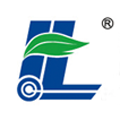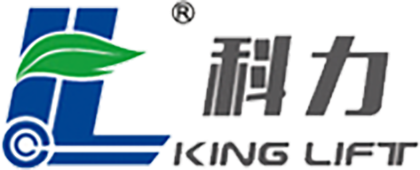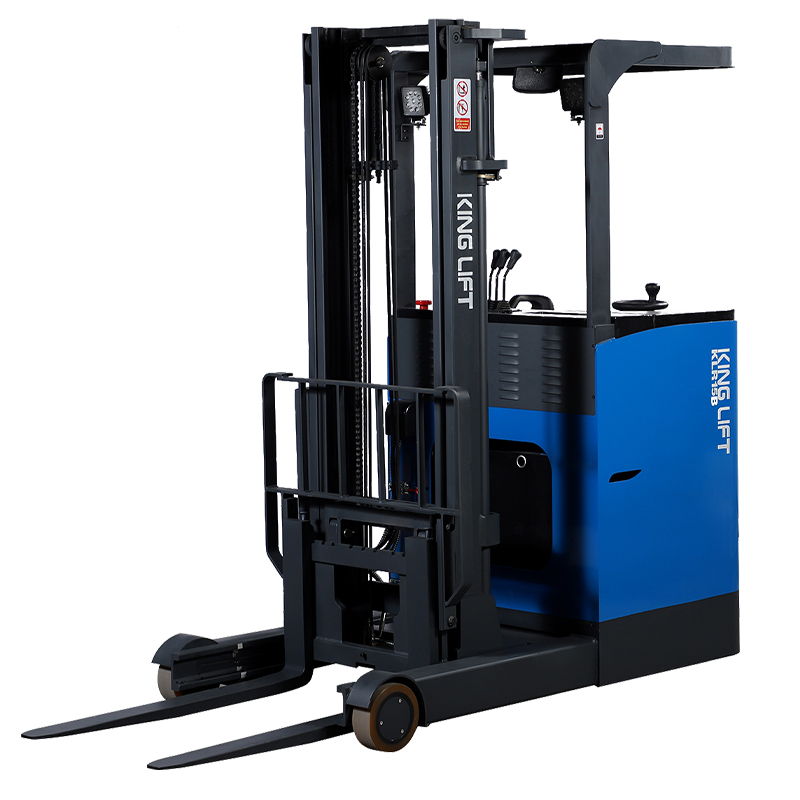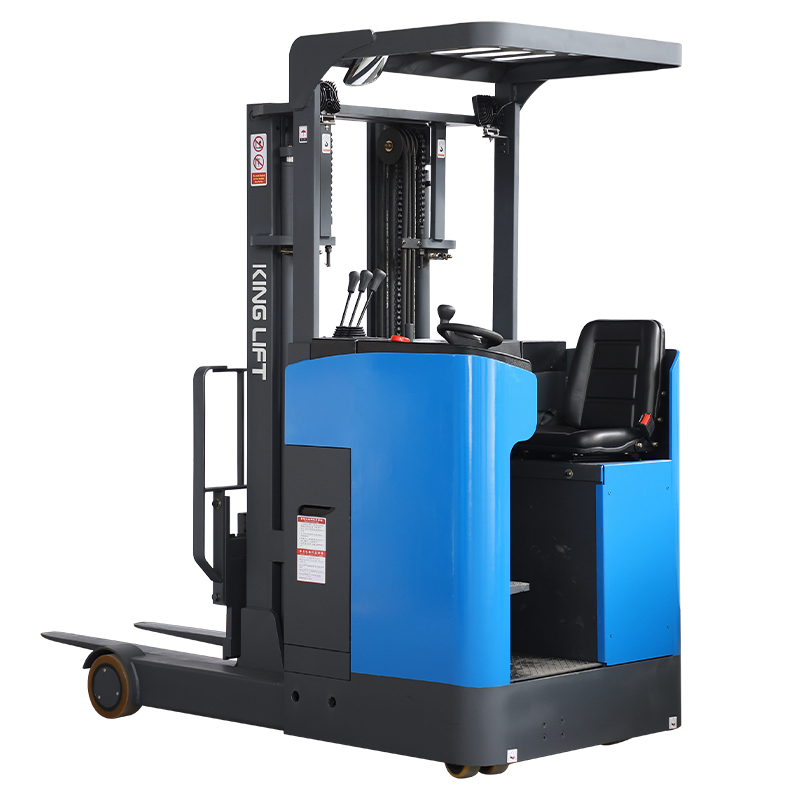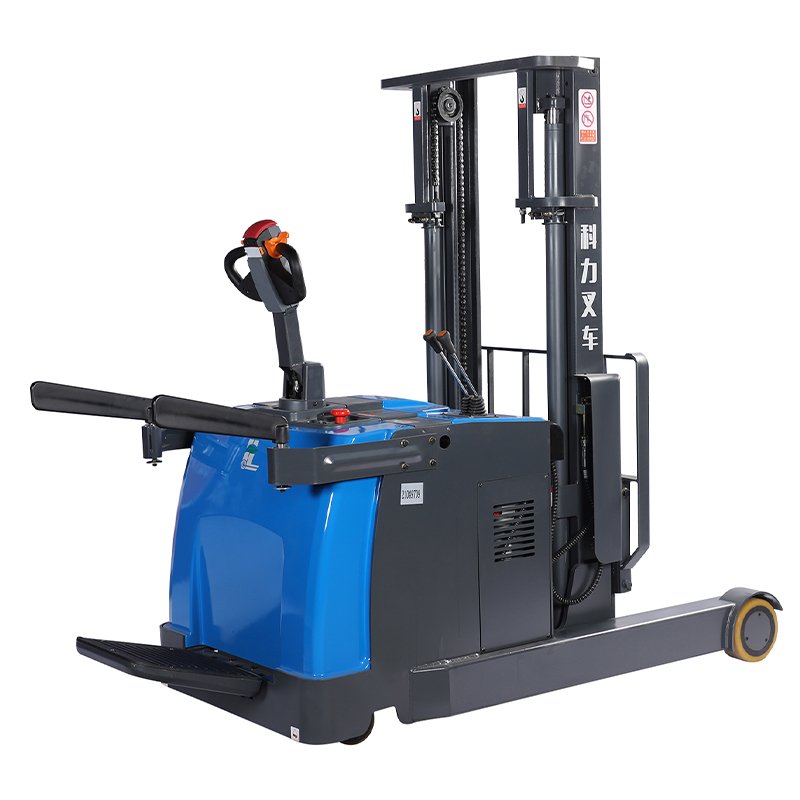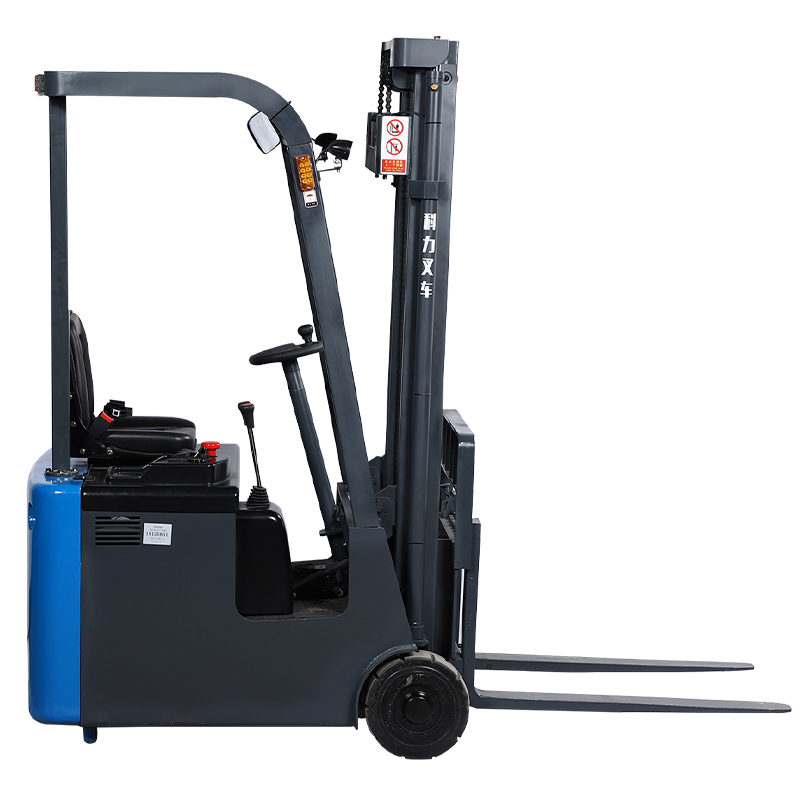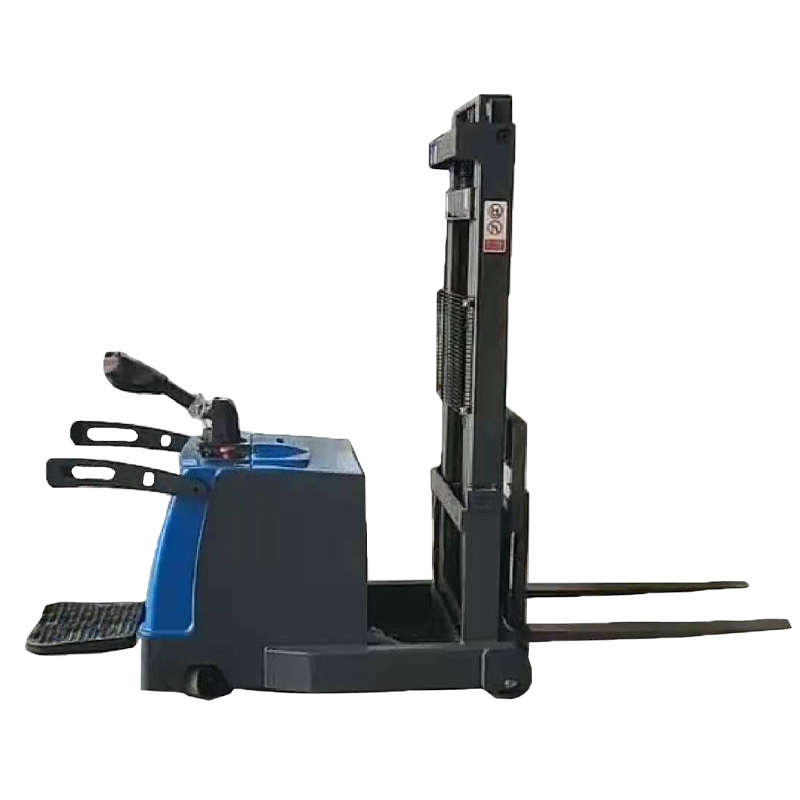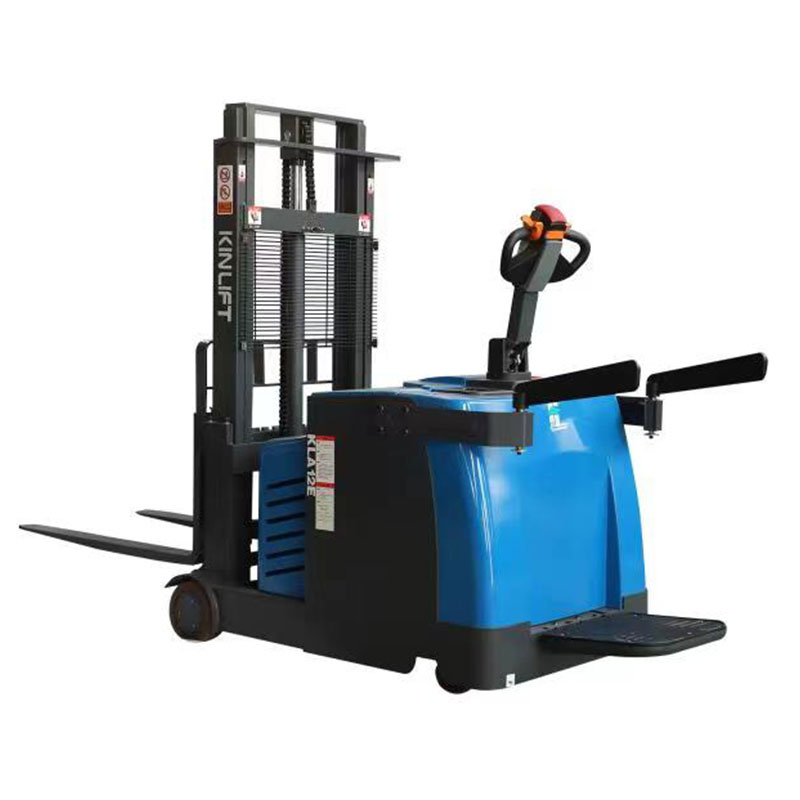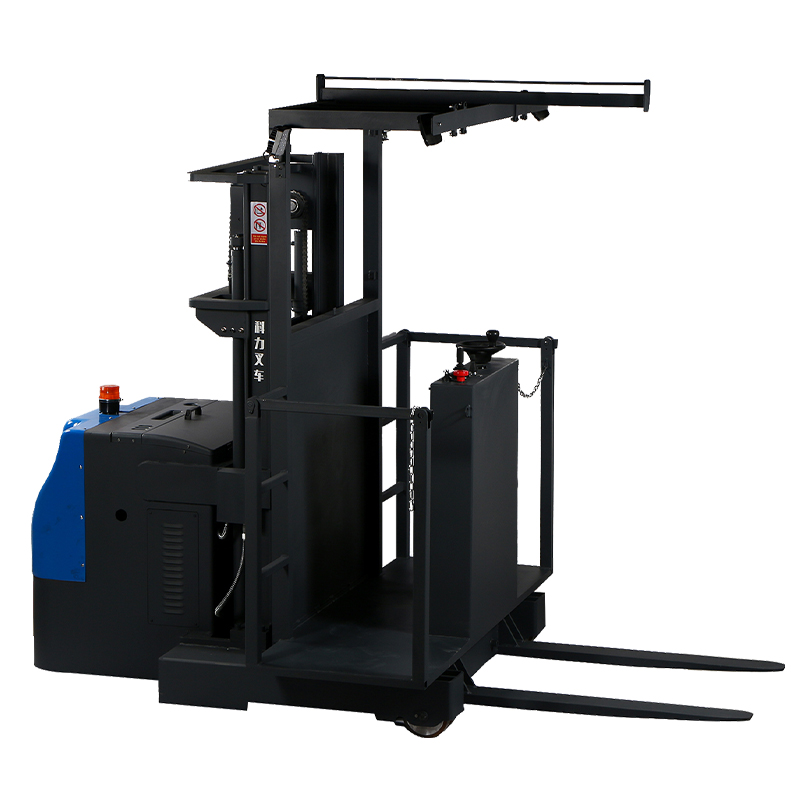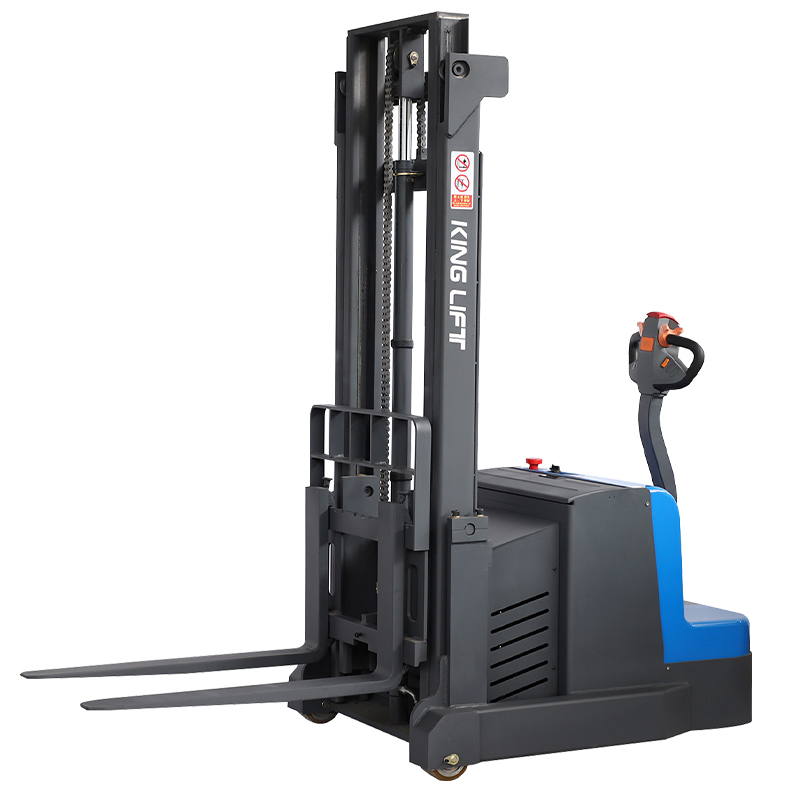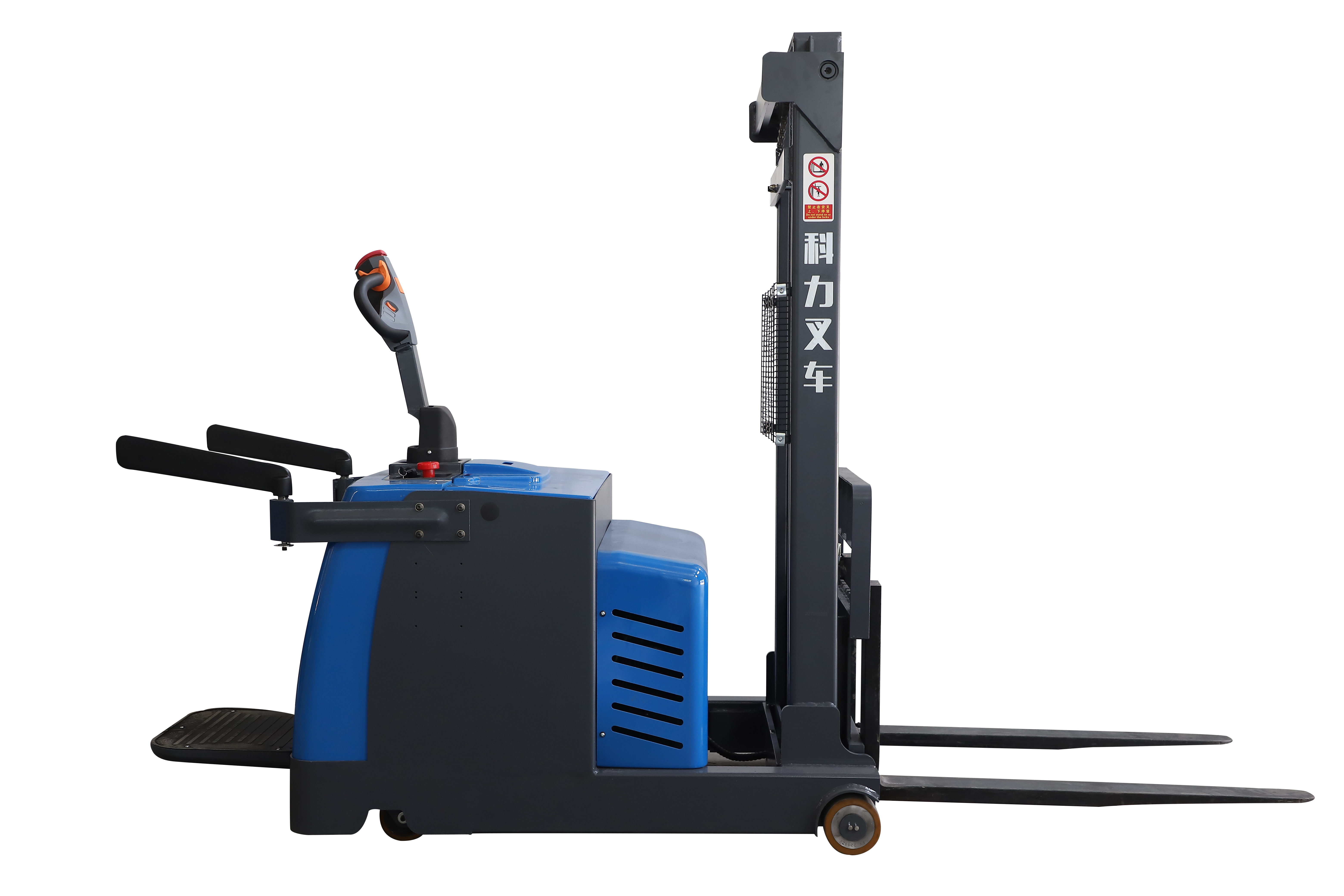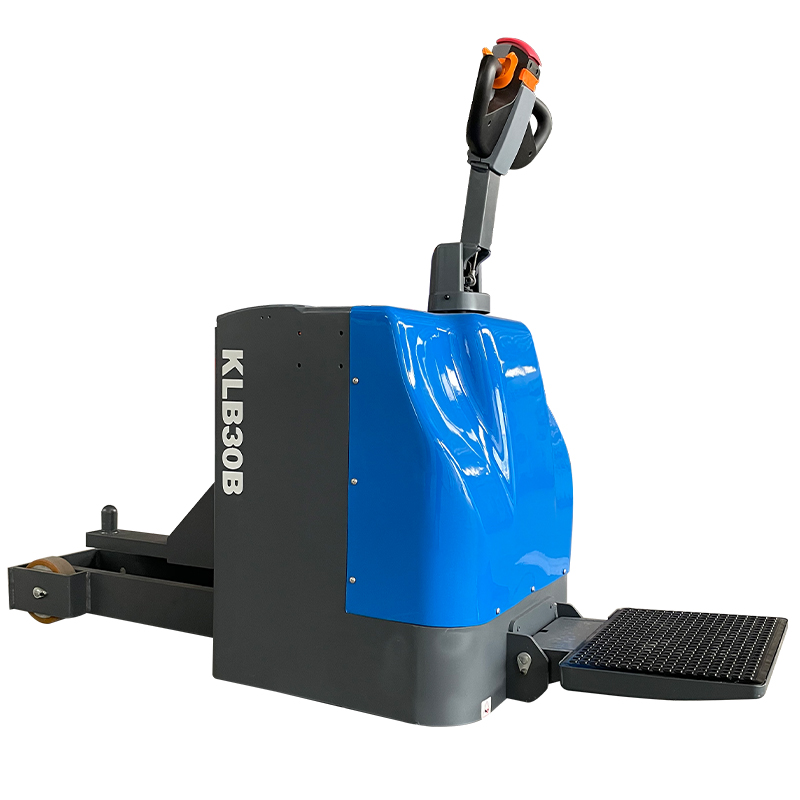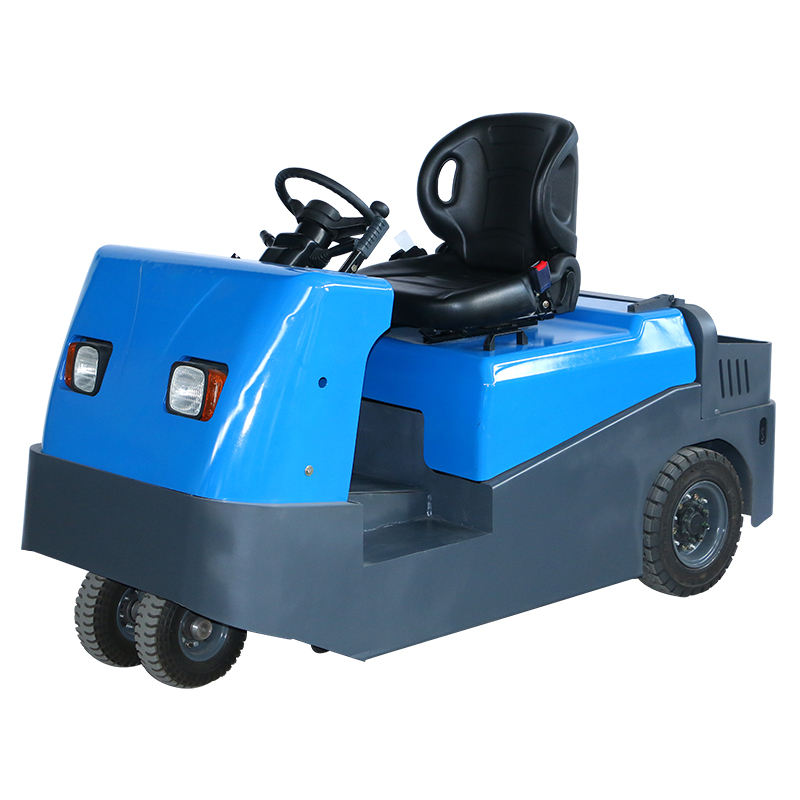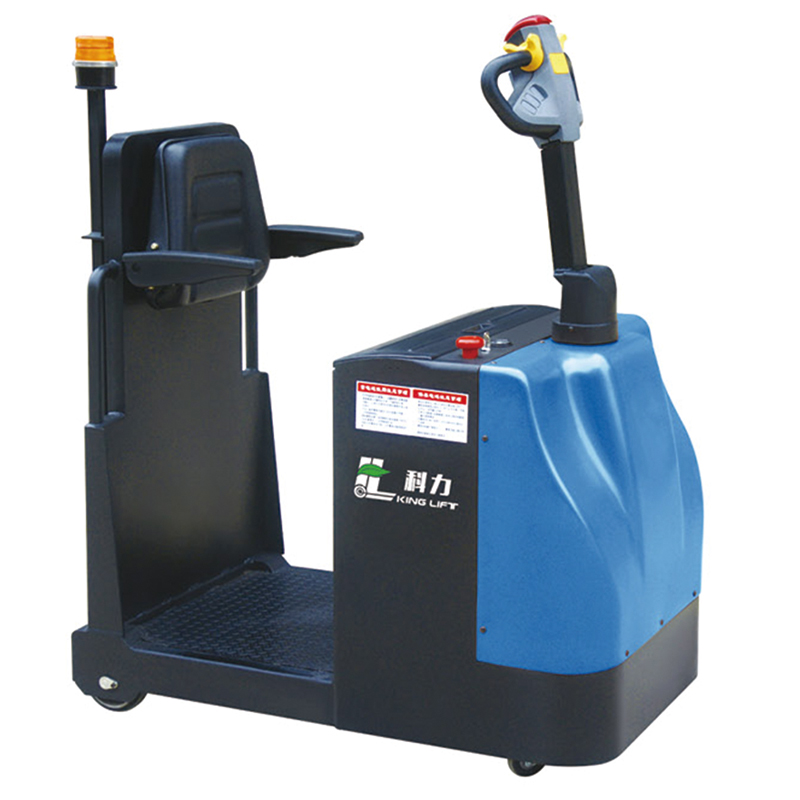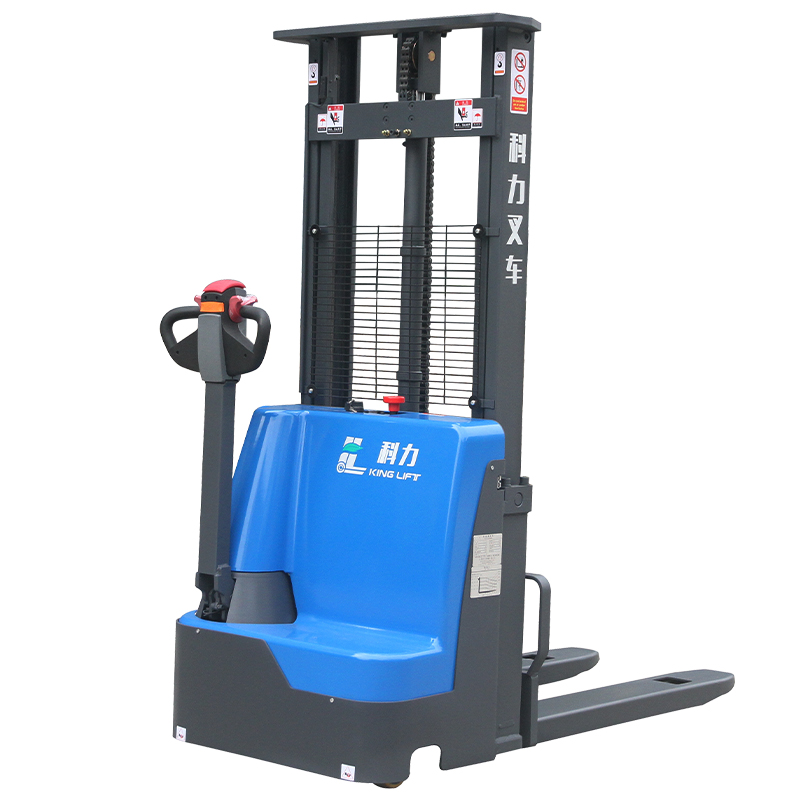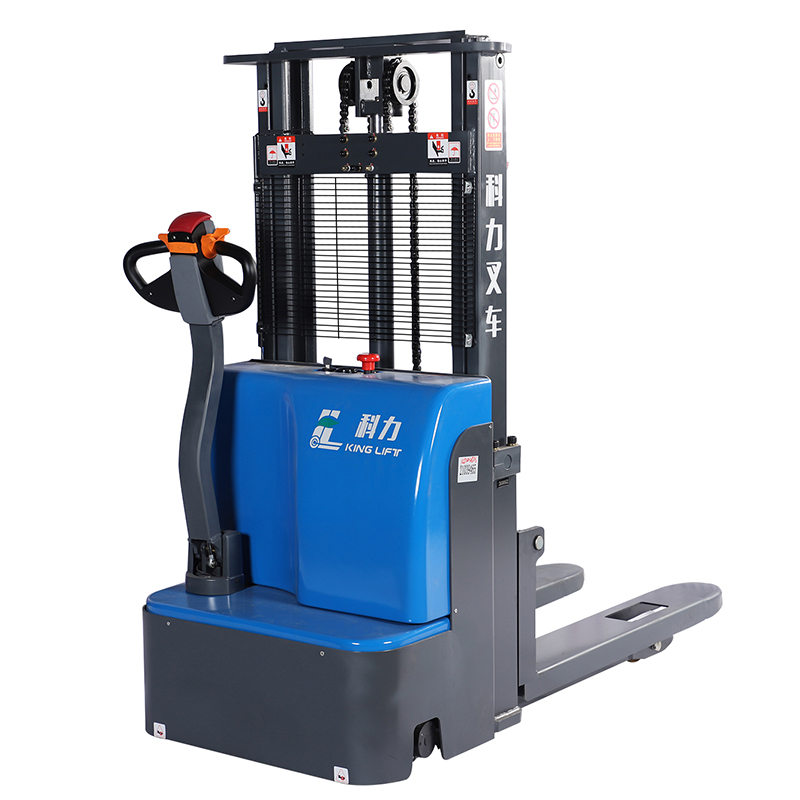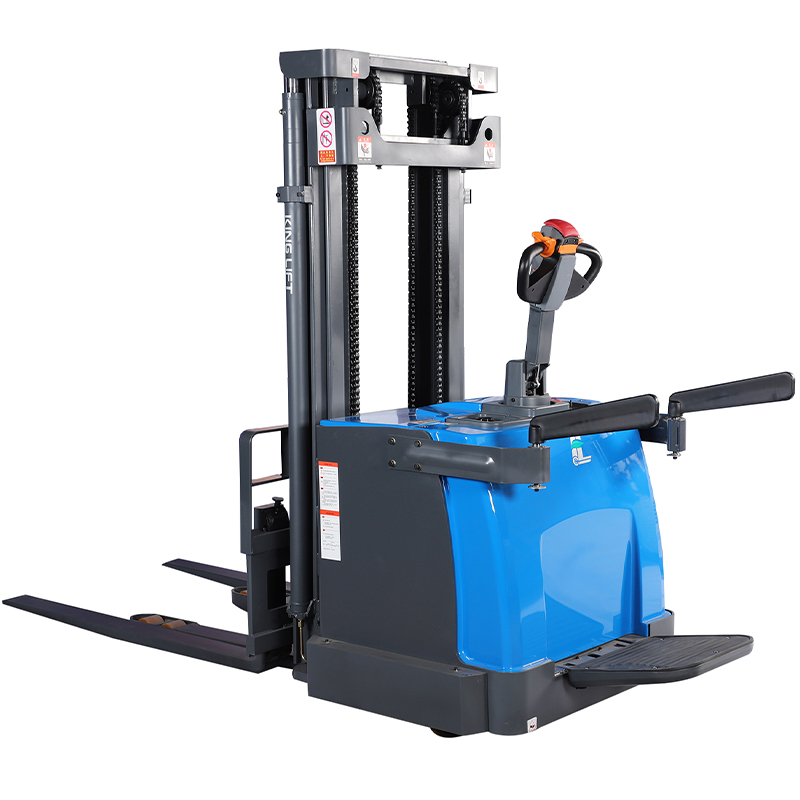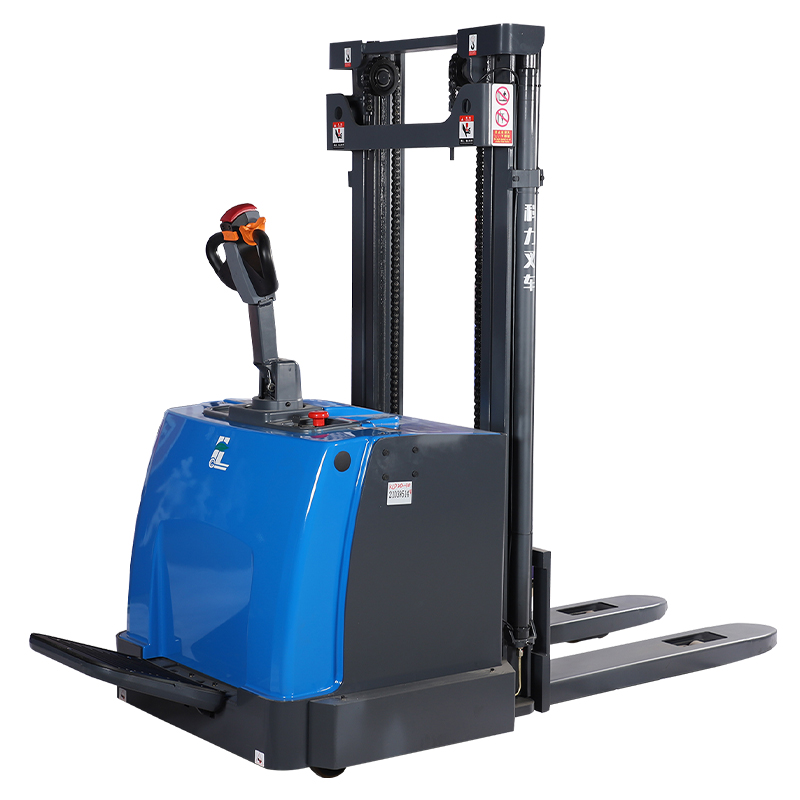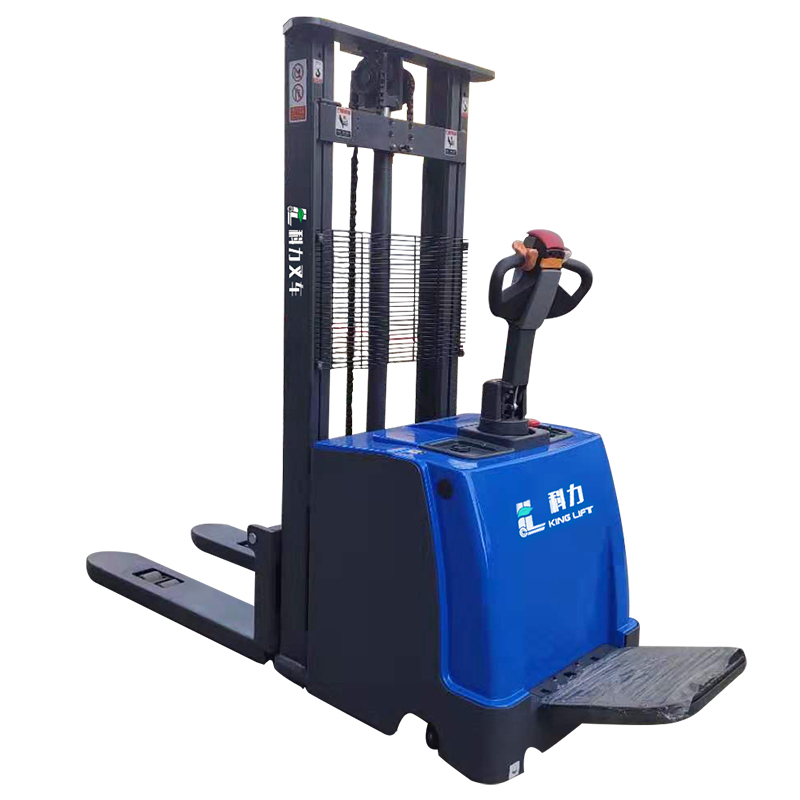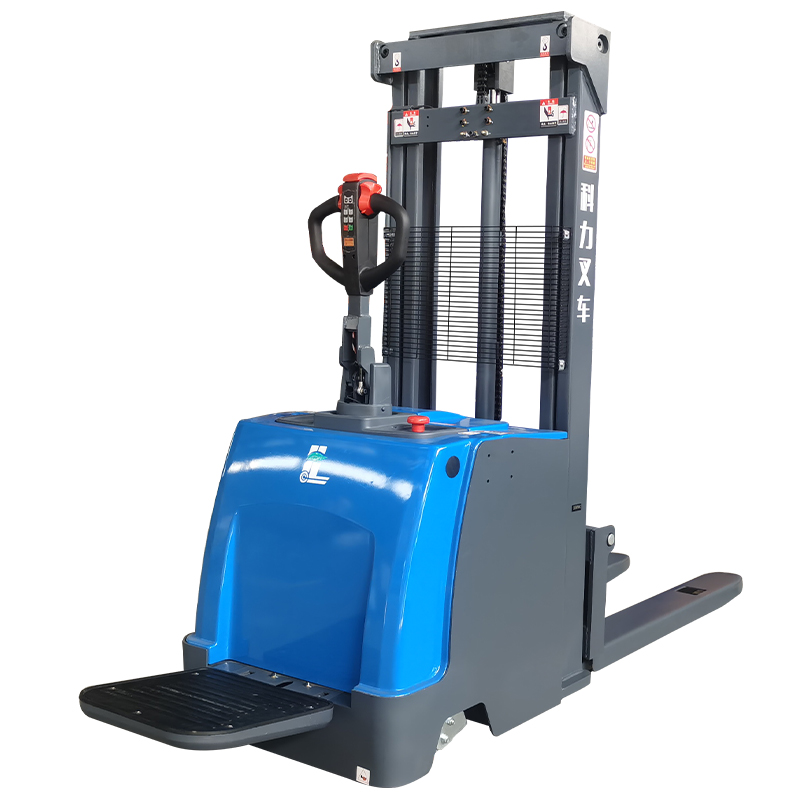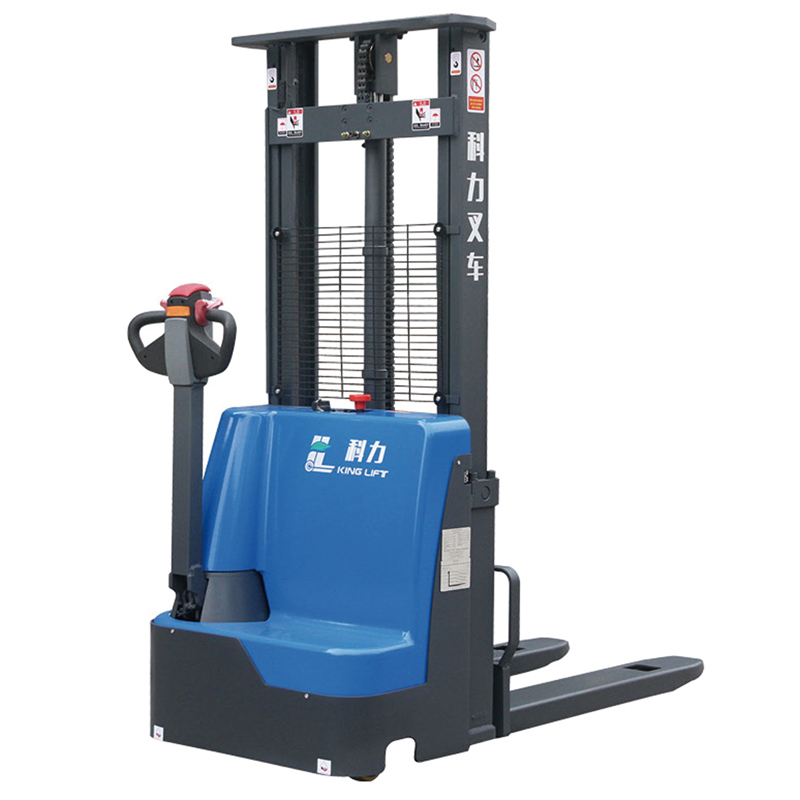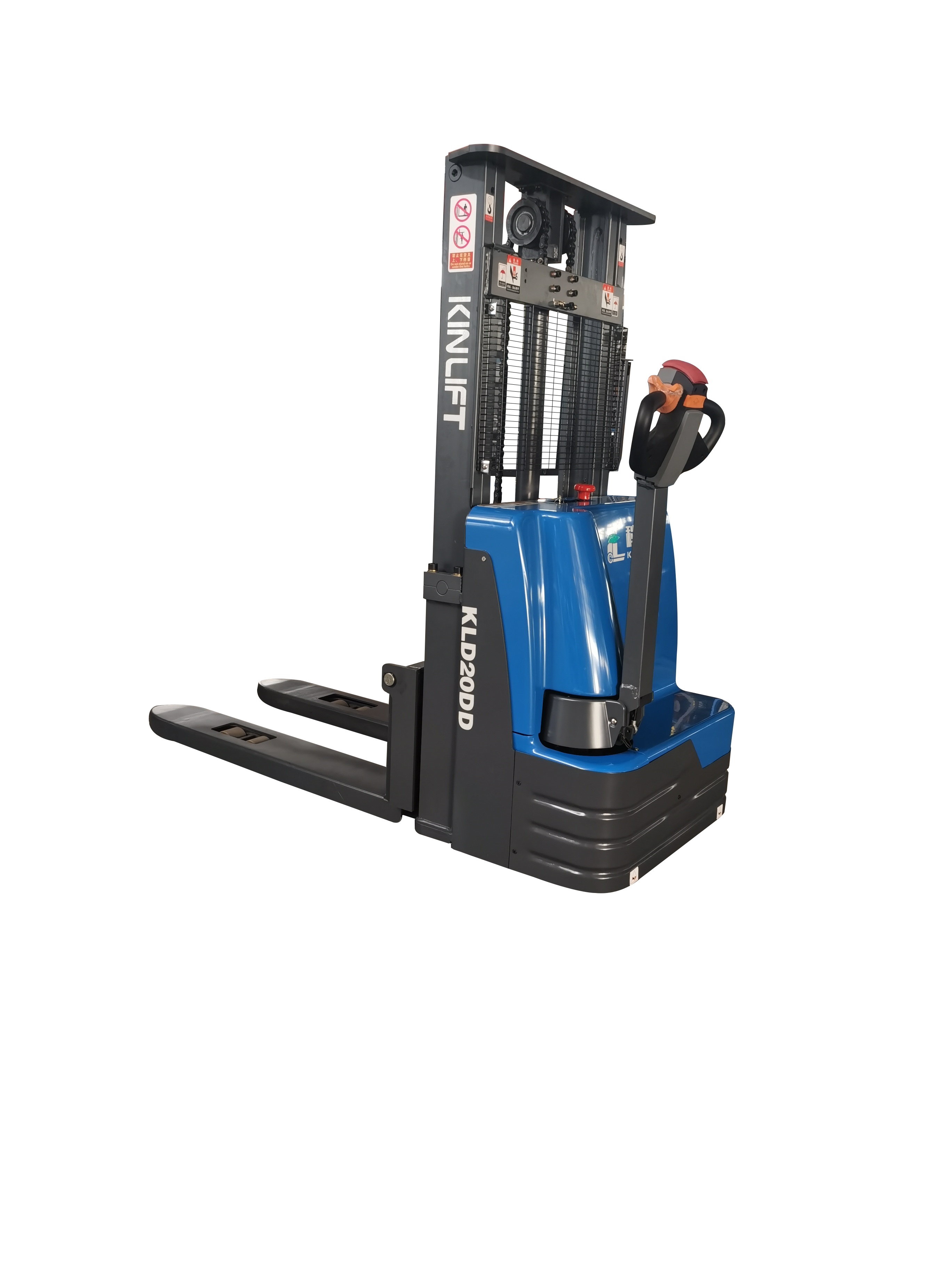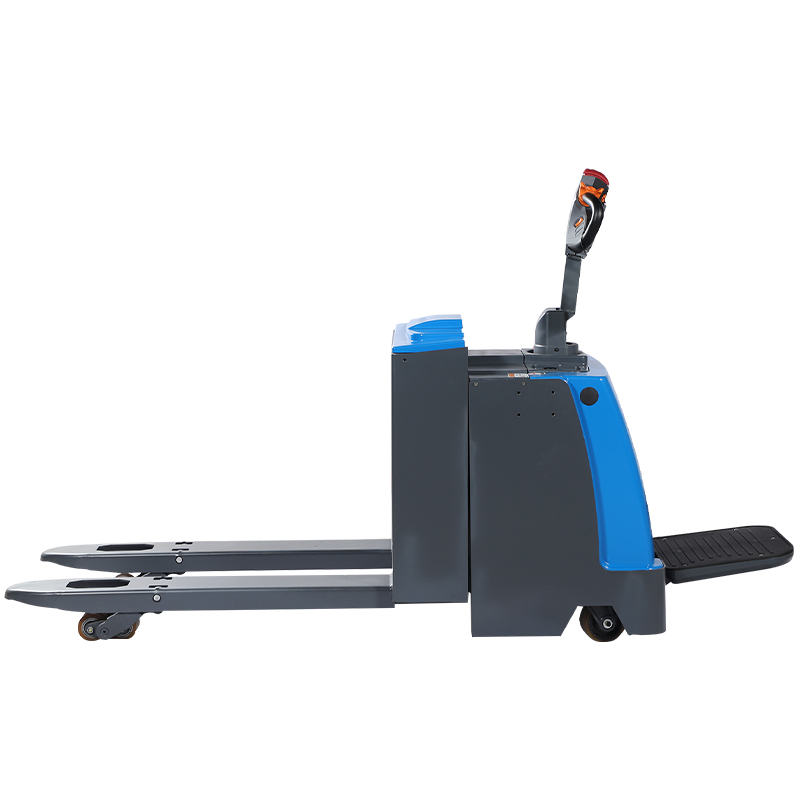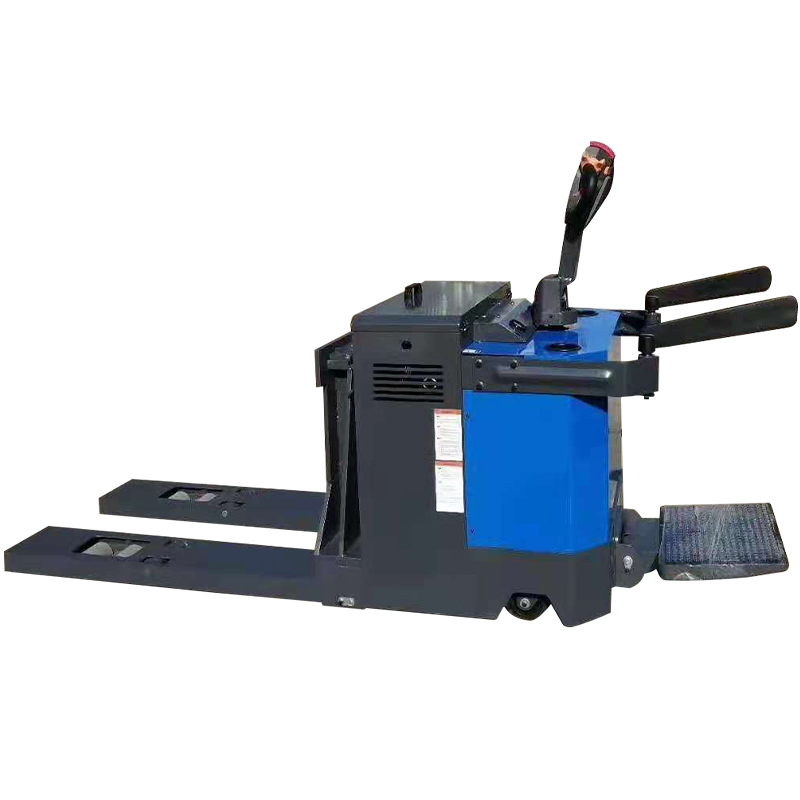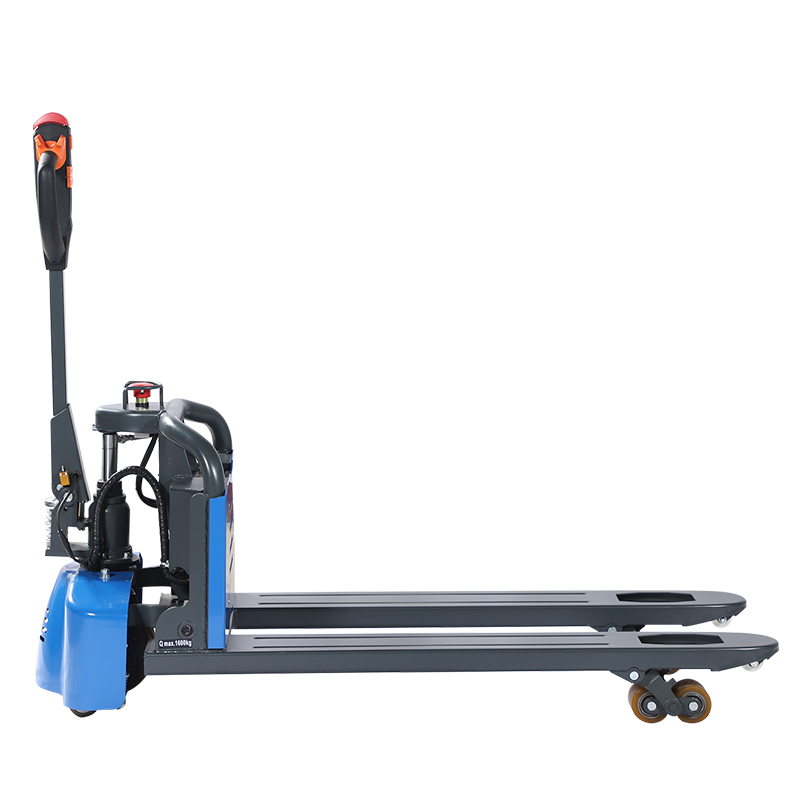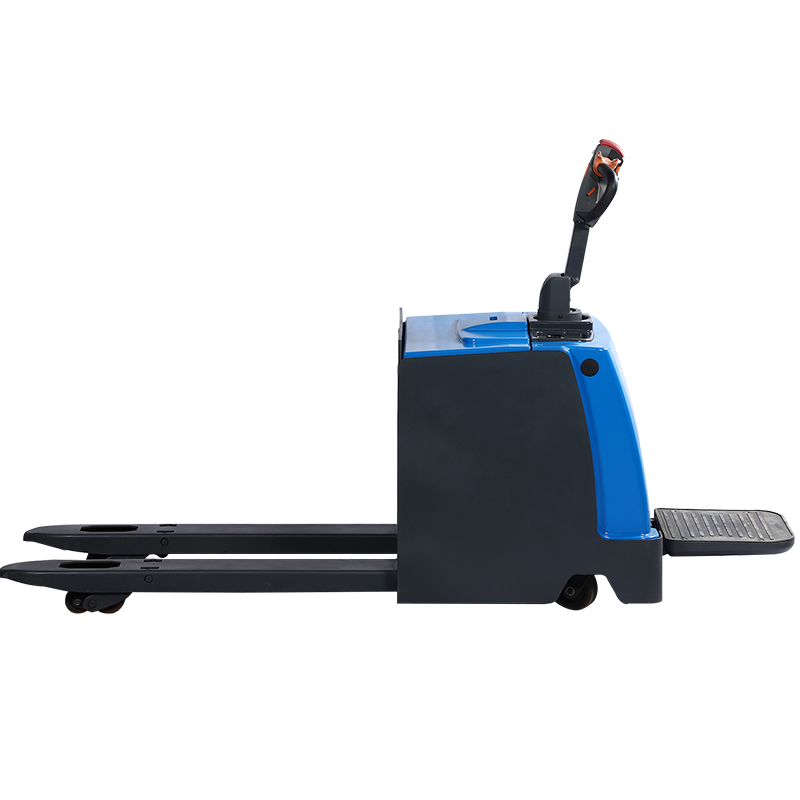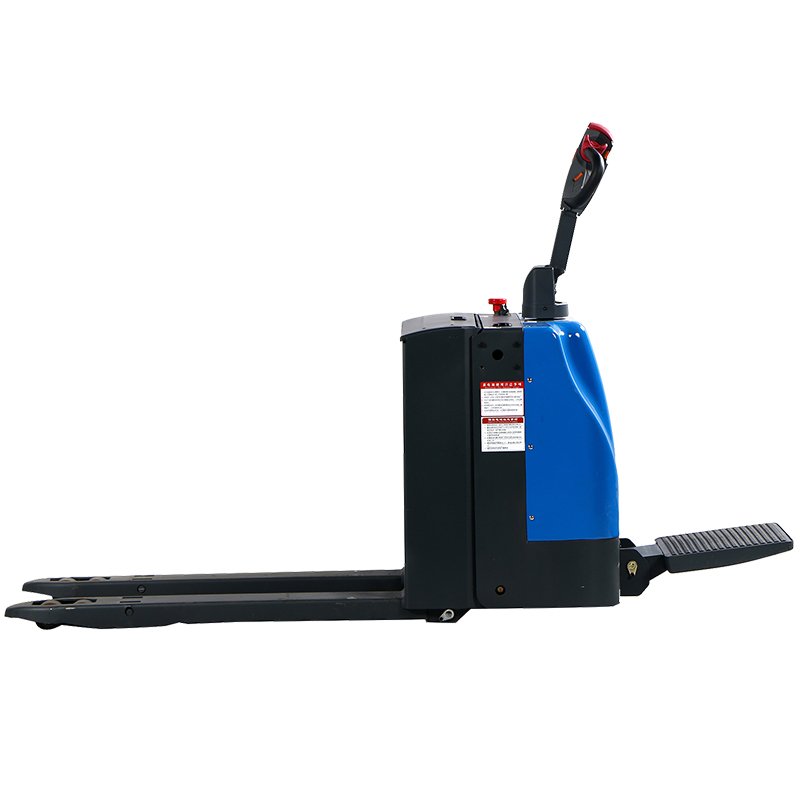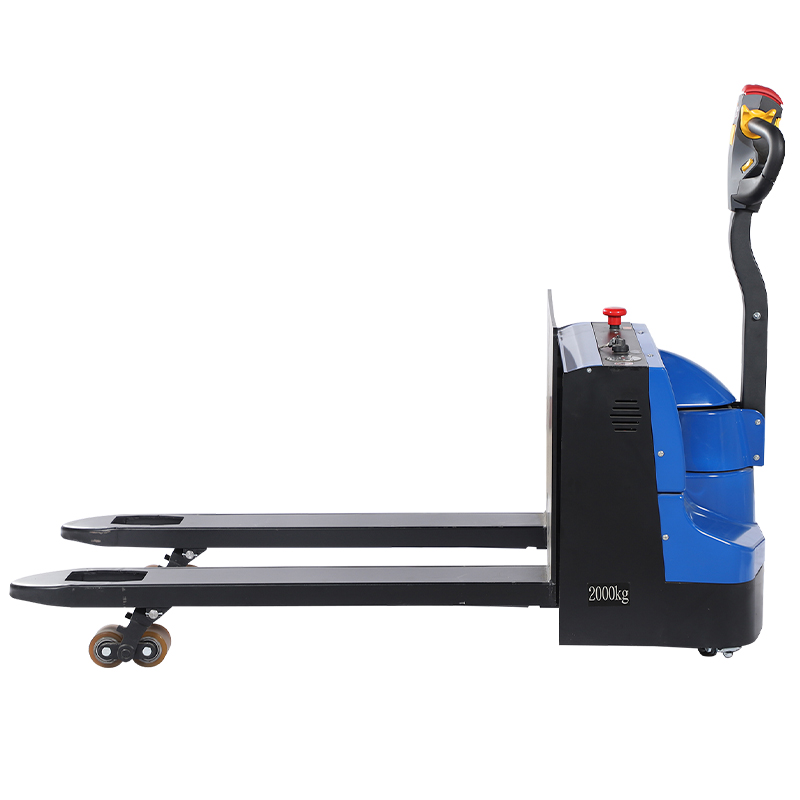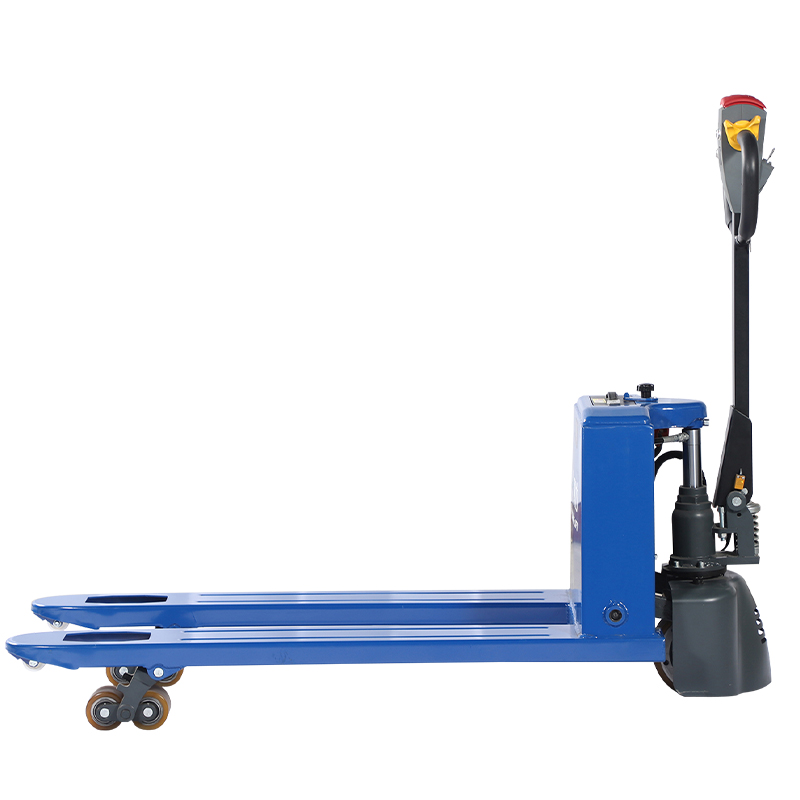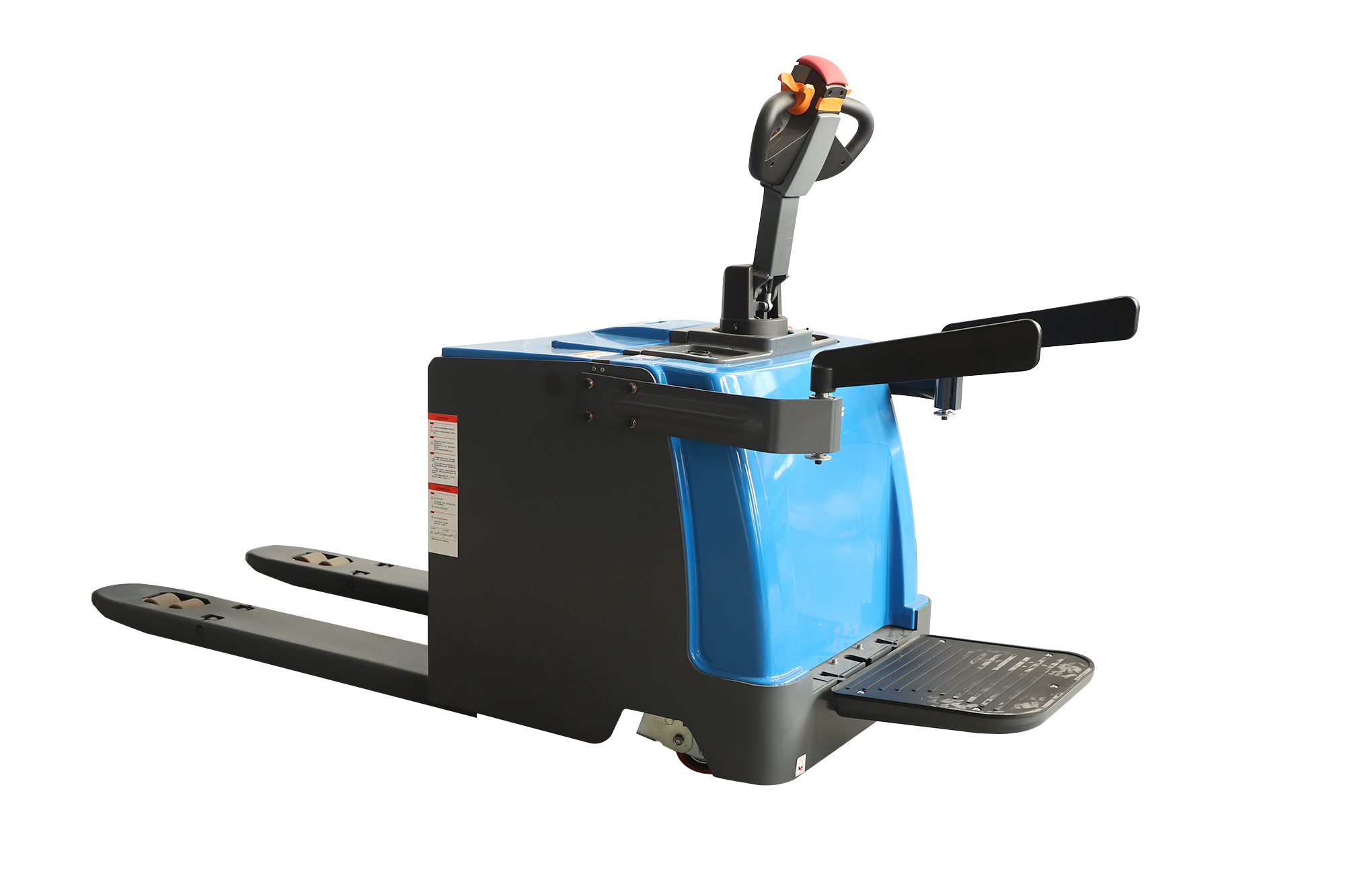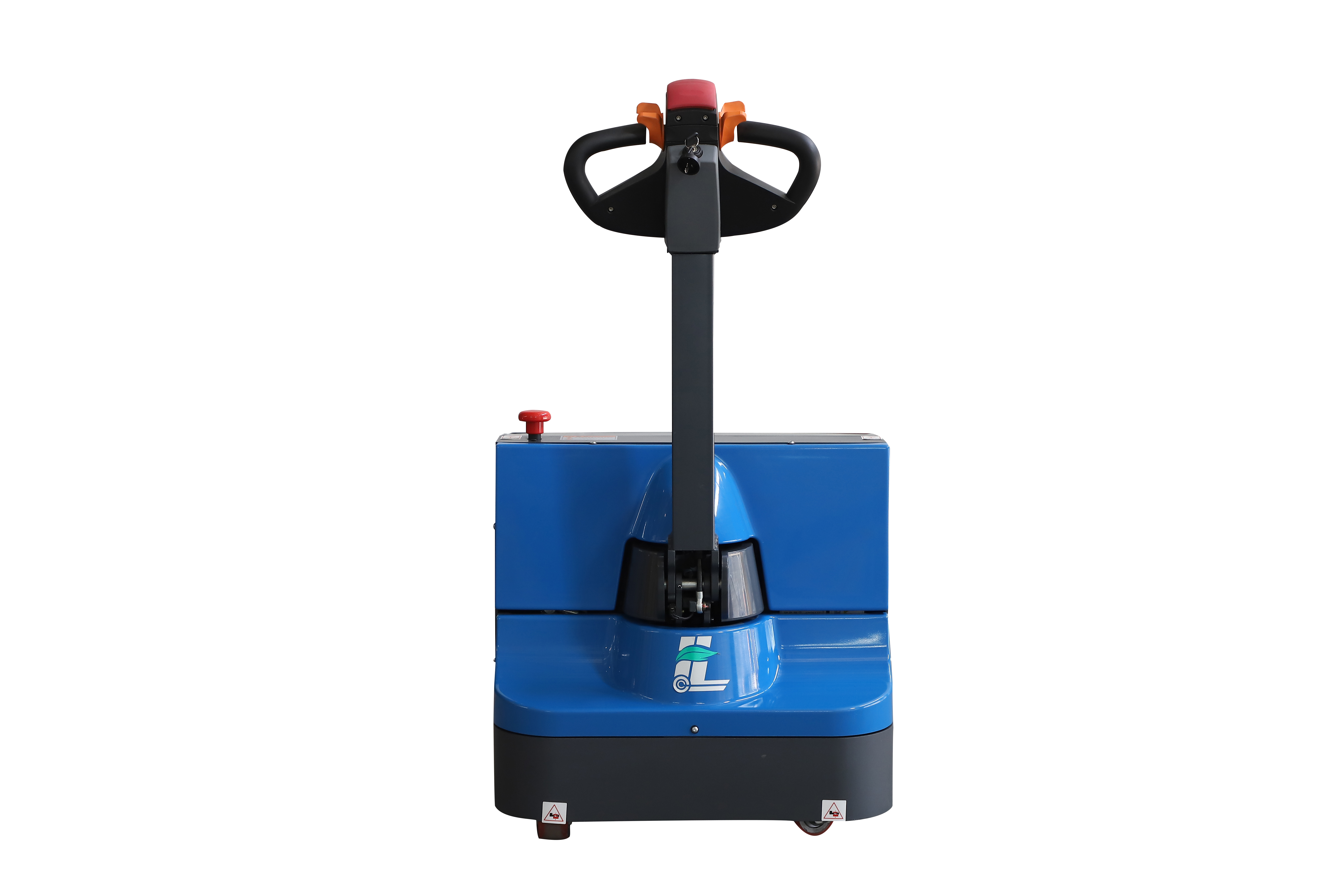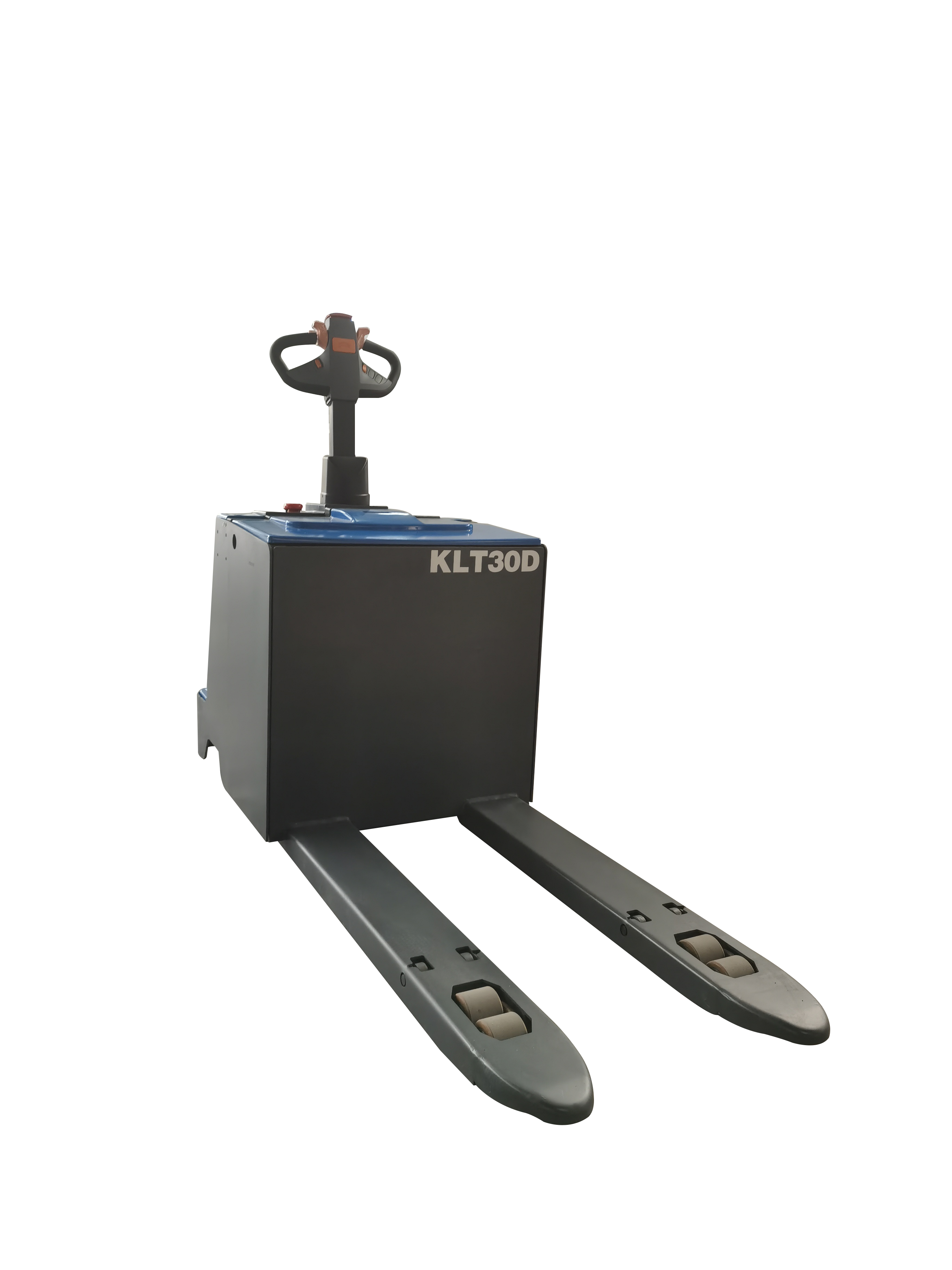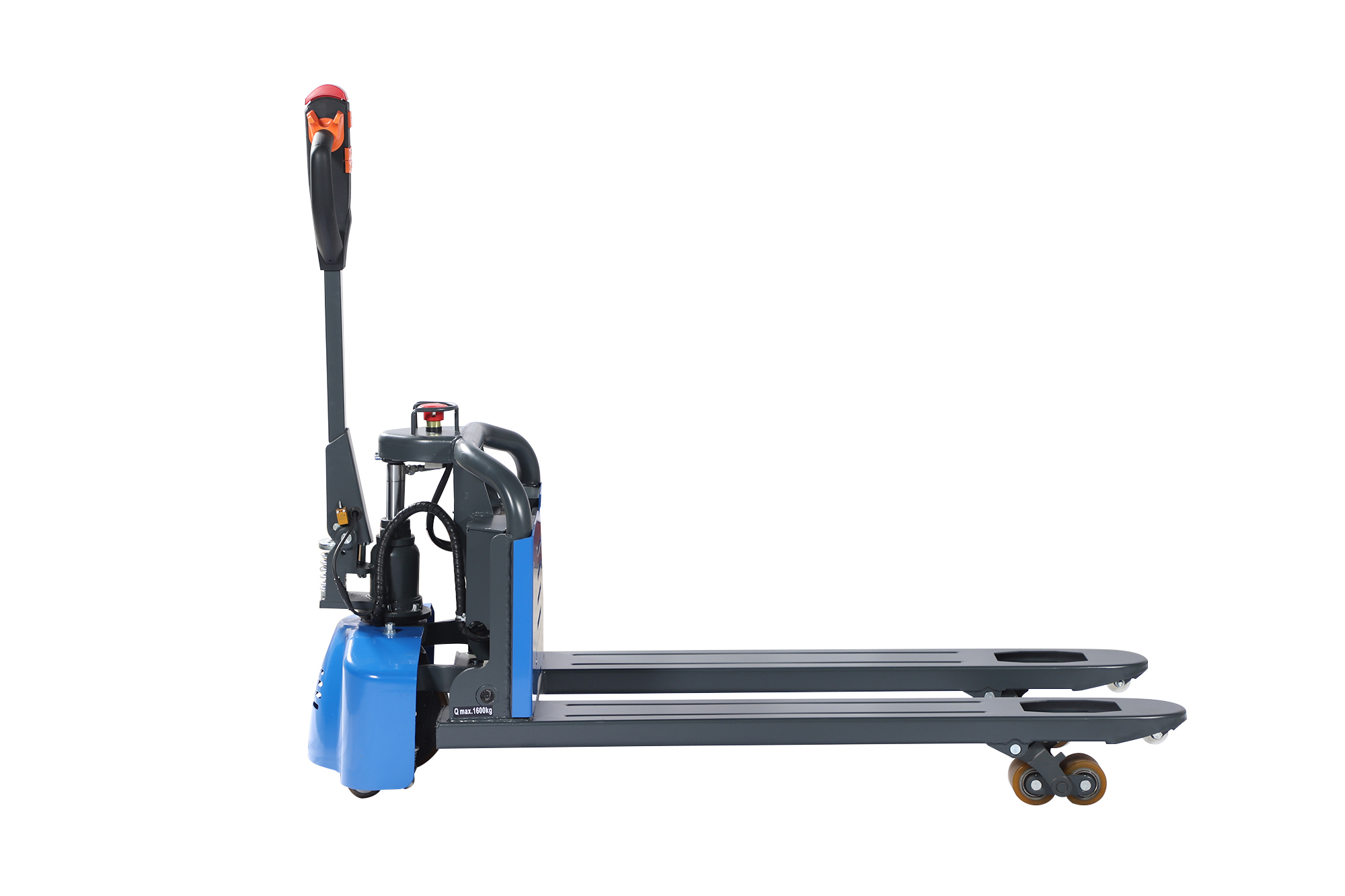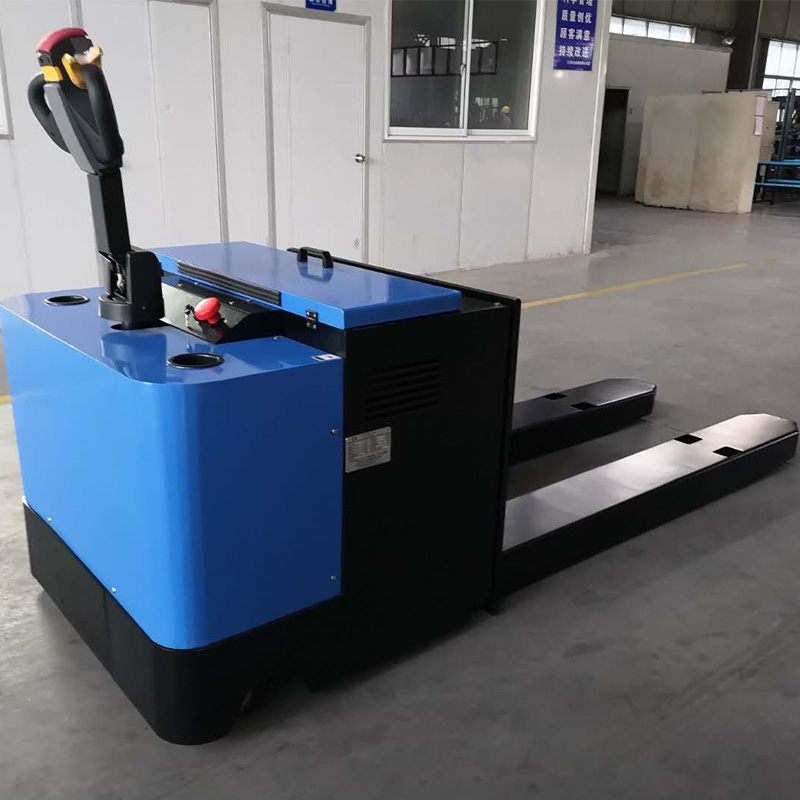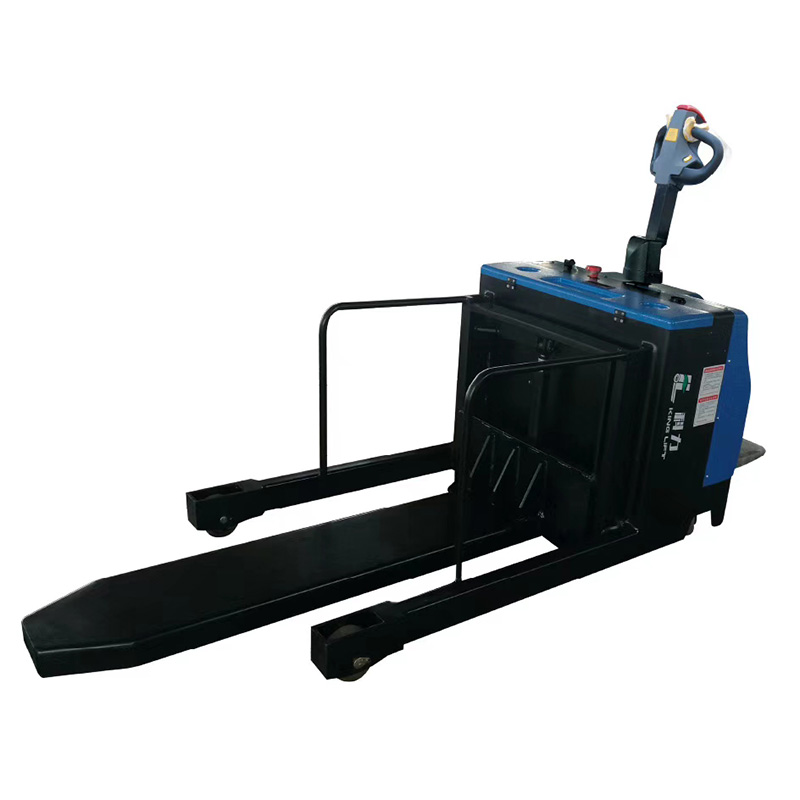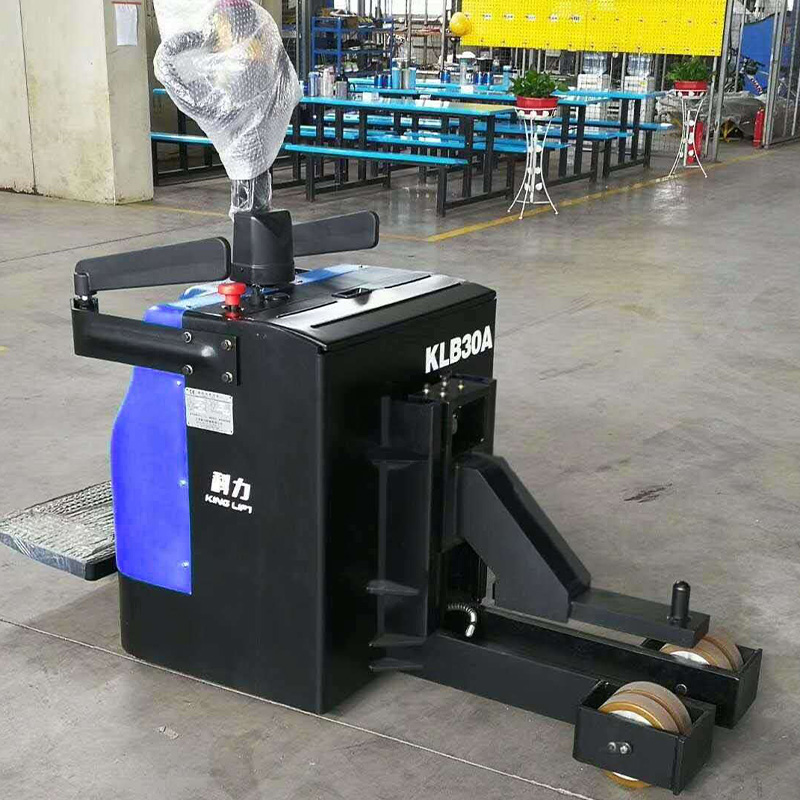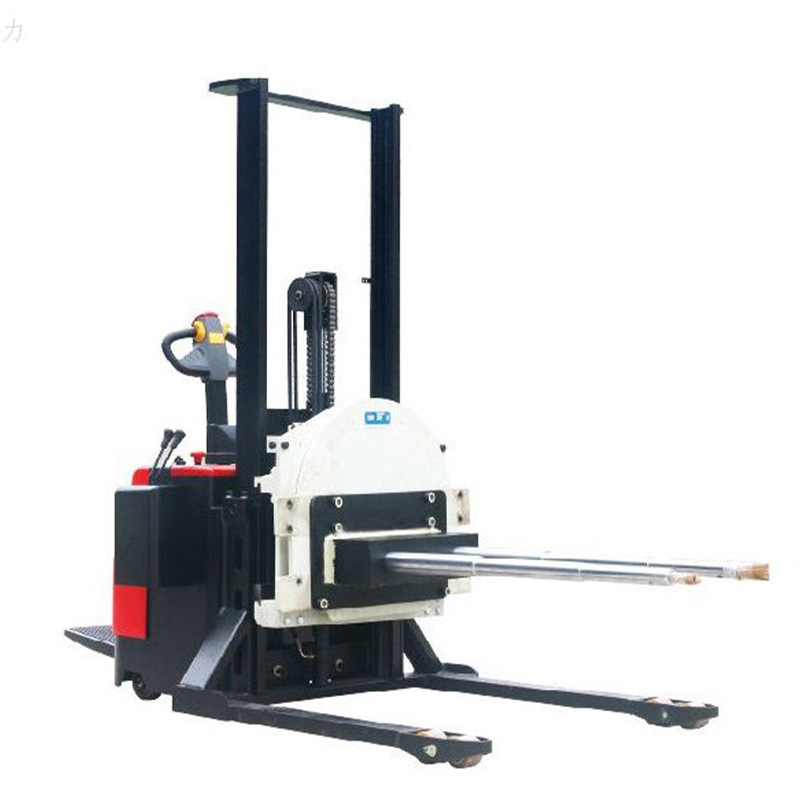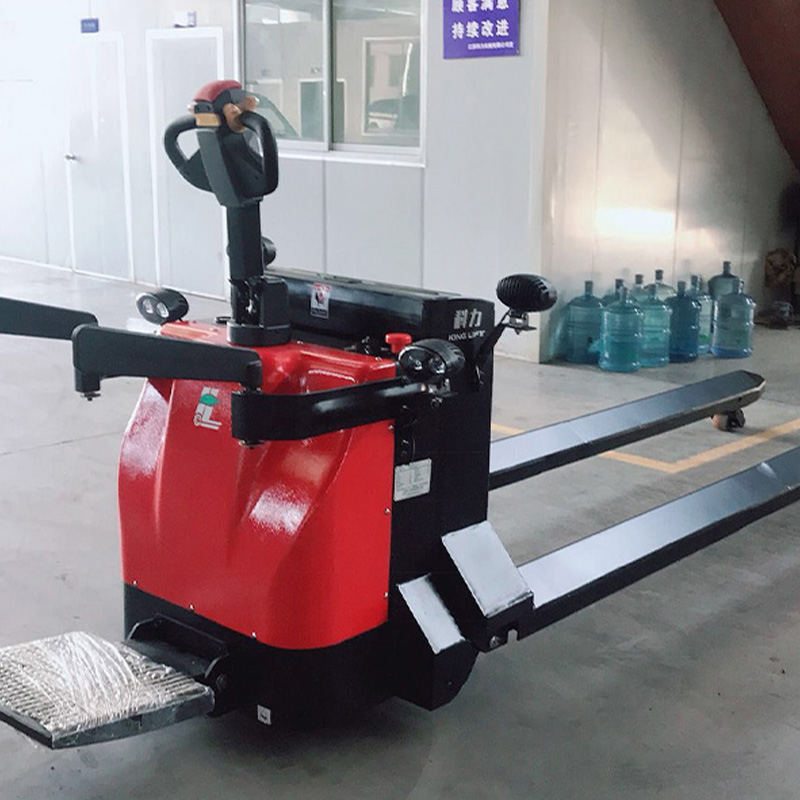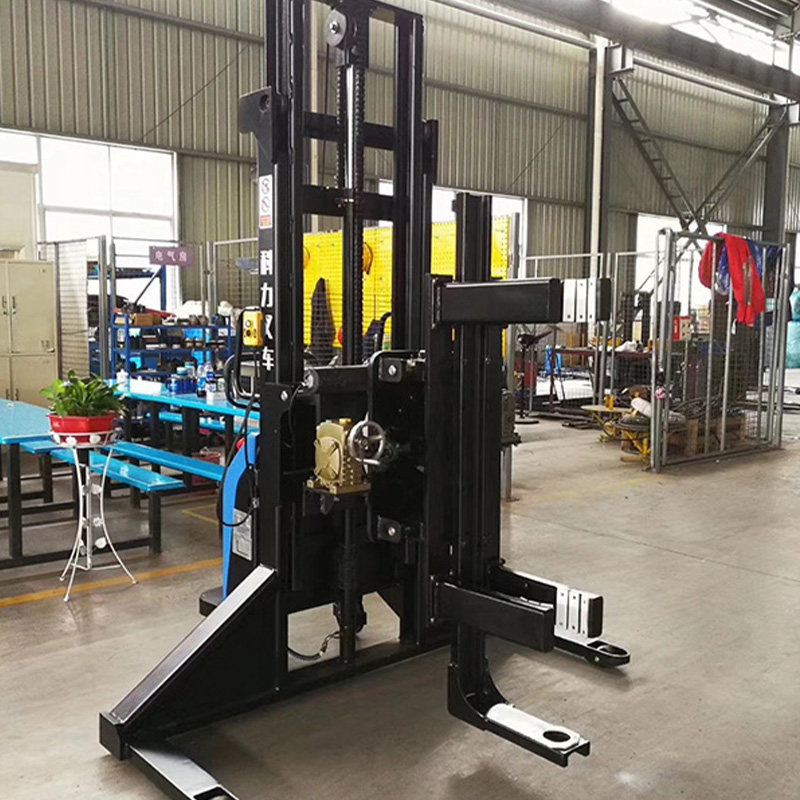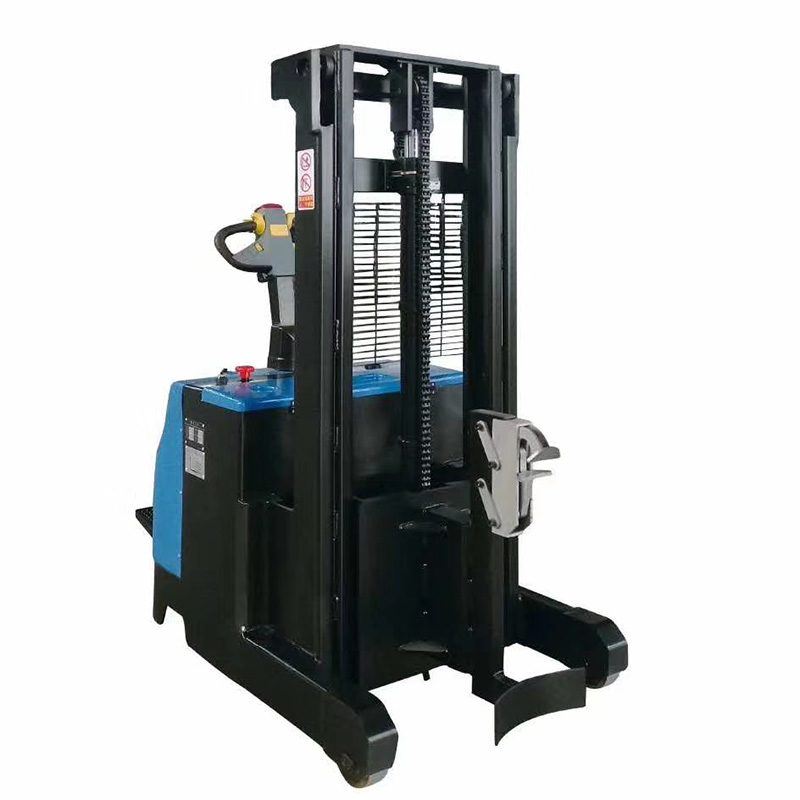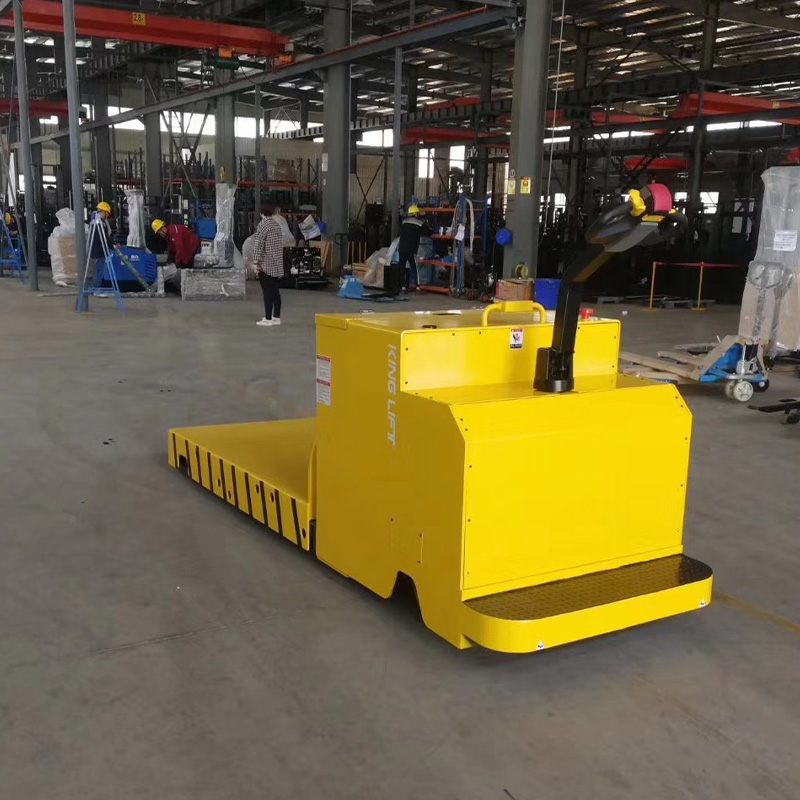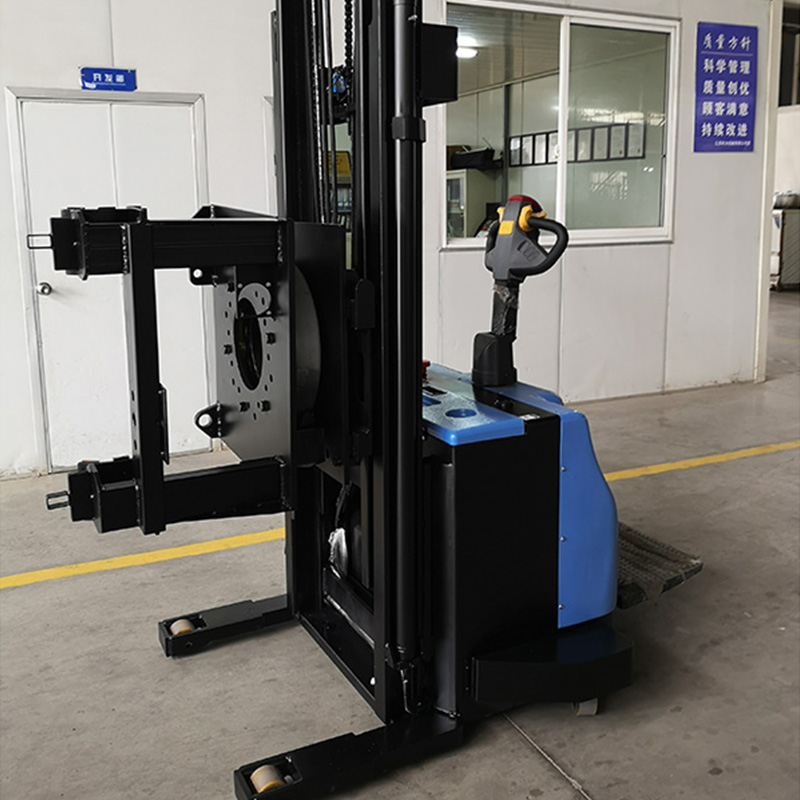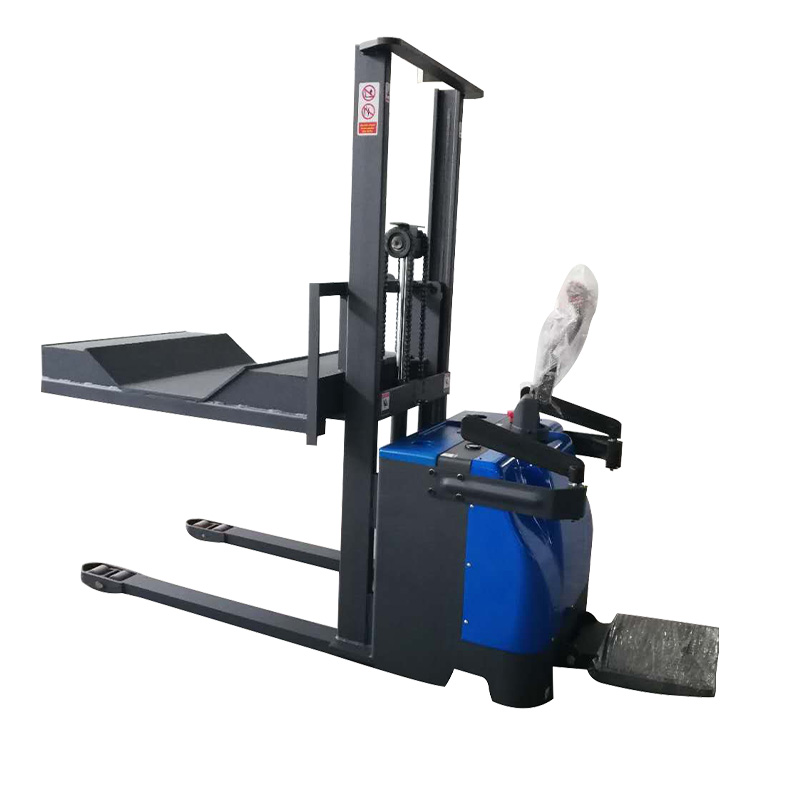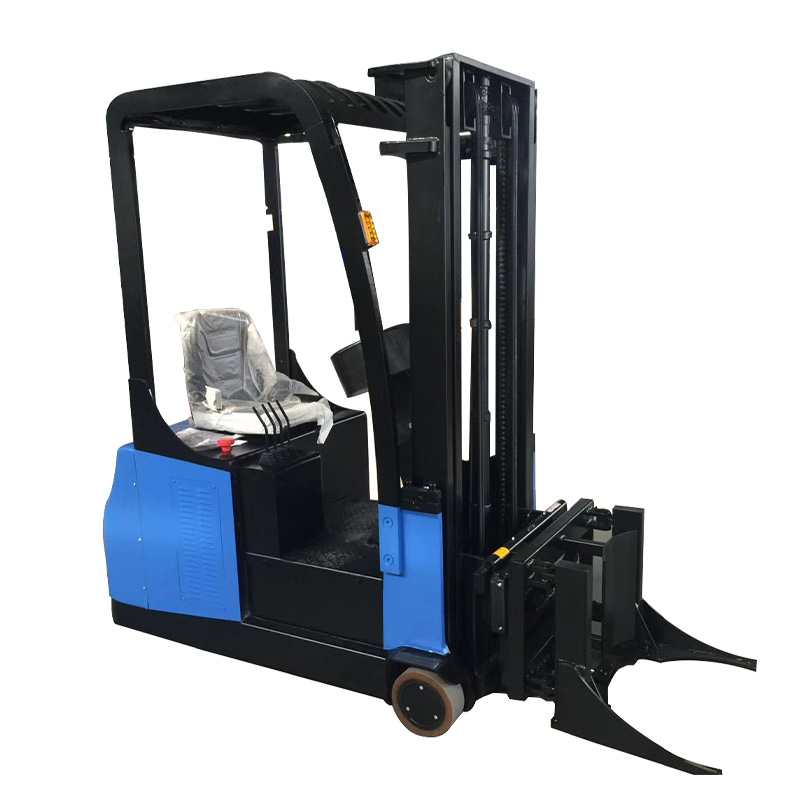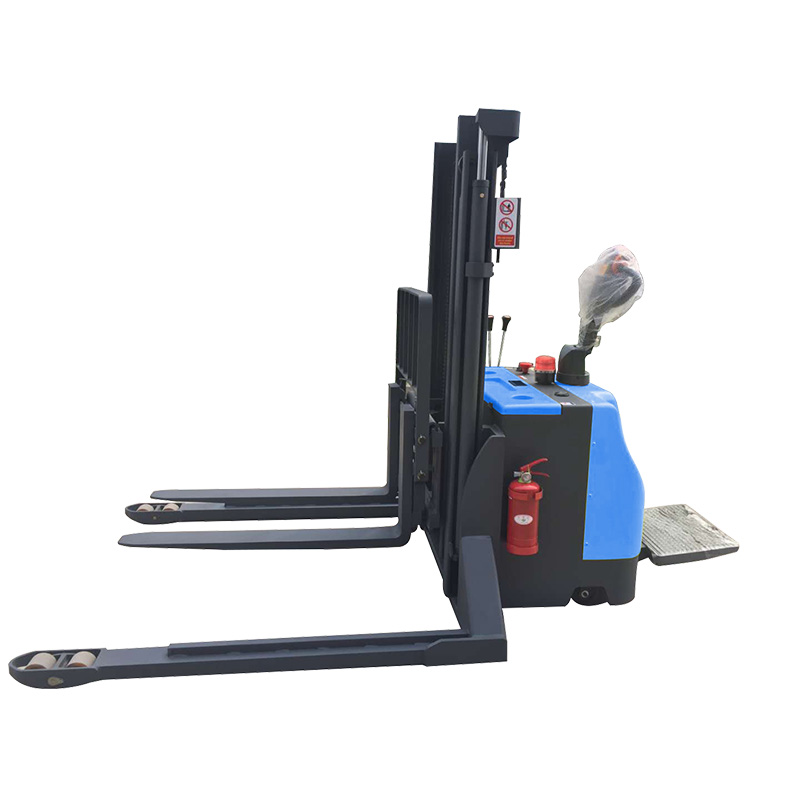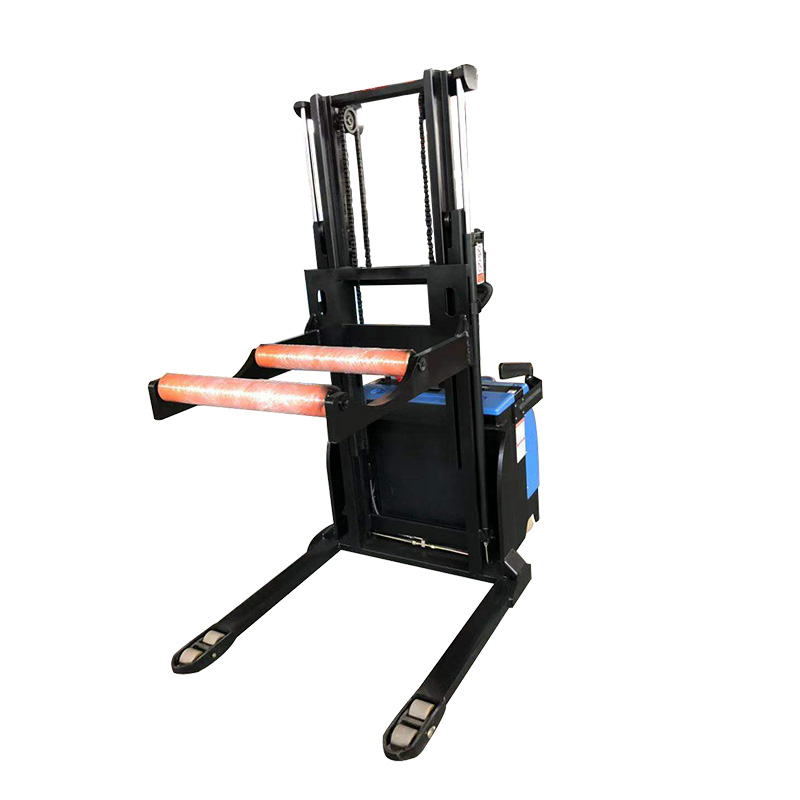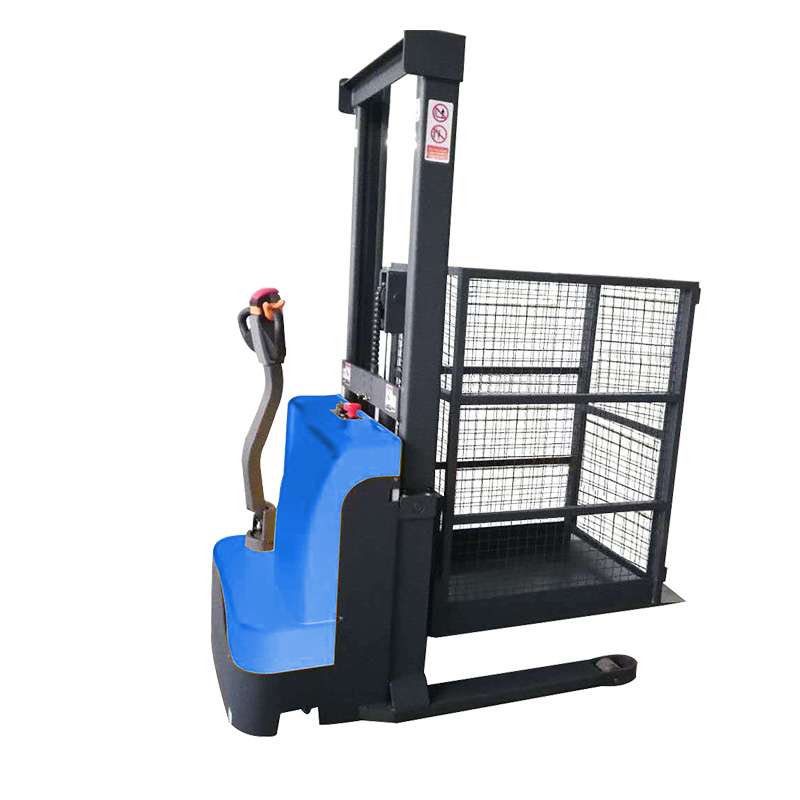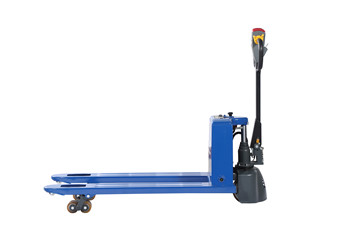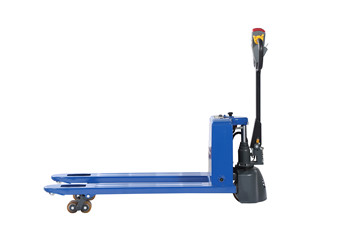-
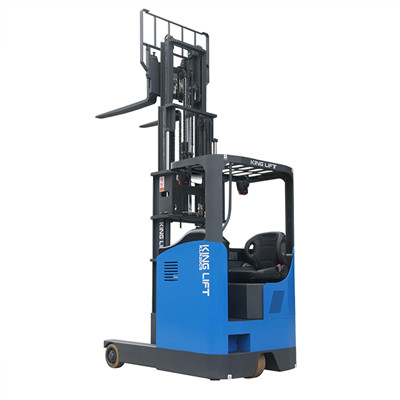 Efficient Material Handling with 4 Wheel Electric ForkliftsAugust 16, 2023
Efficient Material Handling with 4 Wheel Electric ForkliftsAugust 16, 20234 Wheel Electric Forklifts: A Game-Changer for Efficient Material Handling
In the fast-paced world of industrial and commercial operations, the importance of efficient material handling cannot be overstated. This is where 4 Wheel Electric Forklifts shine as versatile solutions for moving heavy loads with ease. These advanced electric lift trucks are not only environmentally friendly but also remarkably adaptable to various environments.
Exceptional Features of 4 Wheel Electric Forklifts
One notable feature that sets 4 Wheel Electric Forklifts apart is their ability to seamlessly handle both single-faced and double-faced pallets. This adaptability makes them a valuable asset in warehouses, factories, and distribution centers, where optimizing space is crucial. Take, for example, the model FB15, boasting a remarkable load capacity of 1500 KG.
Efficiency at Its Core: The USA Curtis AC Controller
Efficiency is at the forefront of 4 Wheel Electric Forklifts' design. Equipped with the USA Curtis AC controller, these forklifts deliver precision and power, ensuring seamless operation even in demanding environments. Whether it's navigating tight spaces or moving heavy loads, these forklifts excel on all fronts.
Cutting-Edge Battery Technology
One highlight of these forklifts is their utilization of advanced Chinese batteries. These batteries not only provide reliable performance but also offer exceptional convenience. They can be easily removed from the forklift using two convenient methods: from the top or from the side. This flexibility streamlines maintenance and ensures uninterrupted workflow.

Illuminate Your Path with LED Lamp
Operating in low-light conditions? No problem. 4 Wheel Electric Forklifts come equipped with LED lamps, enhancing visibility and safety even in dimly lit areas. This feature ensures efficient operation and reduces the risk of accidents, contributing to a safer work environment.
Quality You Can Trust: Famous Brand Battery and Charger
When it comes to performance and durability, trust is paramount. That's why these forklifts are equipped with batteries and chargers from reputable and well-known brands. This commitment to quality guarantees consistent and reliable performance, minimizing downtime and maximizing productivity.
Innovation in Control: Inmotion, Curtis, Zapi AC Controller
The driving force behind these forklifts' exceptional performance lies in their advanced AC controllers. Whether it's Inmotion, Curtis, or Zapi, these controllers are designed to optimize efficiency, precision, and control. They empower operators to navigate various tasks effortlessly, from heavy lifting to intricate maneuvering.
Conclusion: Transforming Material Handling Efficiency
4 Wheel Electric Forklifts are more than just machines; they're transformative tools that enhance efficiency, productivity, and safety across industries. With their adaptability, precision, and environmentally friendly features, these forklifts redefine the landscape of material handling. For a partner in revolutionizing your material handling processes, look no further than Kinlift pallet trucks. As a professional Electric Counterbalanced 4-wheeler Forklift manufacturer and supplier, Kinlift offers a range of high-quality solutions tailored to meet the unique demands of modern operations.
To explore the full potential of Electric Counterbalanced 4-wheel Forklifts, contact Kinlift pallet trucks today and experience a new level of efficiency in material handling.
Contact Information:
Company: Kinlift pallet trucks CO.,LTD
Website: https://www.kinlift.com/
Email: shirley@king-lift.cn / Caroline@king-lift.cn
Phone: +86-13912829038 / +86-13952830082
READ MORE -
 How Does a Forklift WorkAugust 08, 2023
How Does a Forklift WorkAugust 08, 2023Understanding the Basics
What is a Forklift?
A forklift, also known as a lift truck, is a specialized industrial vehicle that's primarily used for lifting and moving heavy materials. It features a pair of forks at the front that can be raised and lowered to carry loads.
Types of Forklifts
There are several types of forklifts, each designed for specific tasks. These include:
Counterbalance Forklifts: These are the most common type of forklifts, featuring a weight at the rear to counterbalance the load at the front.
Reach Trucks: Built for narrow aisles, these forklifts have extendable forks that can reach higher shelves.
Pallet Jacks: Also known as pallet trucks, these are used for short-distance transportation of palletized loads.
Rough Terrain Forklifts: These are designed for outdoor use on uneven surfaces, commonly found in construction sites.
Key Components of a Forklift
Mast
The mast is the vertical assembly on the front of the forklift that houses the lifting mechanism. It consists of interlocking rails and chains that allow the forks to be raised and lowered.
Hydraulics System
The hydraulics system powers the lifting mechanism. When hydraulic fluid is pressurized, it moves the piston in the cylinder, causing the forks to lift or lower.
Counterweight
Counterbalance forklifts have a heavy counterweight at the rear. This weight counterbalances the load being lifted at the front, preventing the forklift from tipping forward.
Operational Mechanism
Lifting and Lowering
When the operator activates the lifting control, hydraulic fluid flows into the cylinder, causing the piston to rise. As a result, the forks are lifted. Lowering the forks involves releasing the hydraulic pressure, allowing gravity to take over.
Steering
Forklifts typically have rear-wheel steering, which offers greater maneuverability. Turning the steering wheel controls the rear wheels, allowing the forklift to pivot around its front wheels.
Propulsion
Most forklifts are powered by electric batteries or internal combustion engines. Electric forklifts produce zero emissions, making them ideal for indoor use, while internal combustion engines are better suited for outdoor applications.
Safety Considerations
Load Capacity
Forklifts are rated for specific load capacities. Exceeding these capacities can lead to instability and accidents.
Stability
Proper load distribution is crucial for maintaining stability. Loads should be centered, and the forklift should not be operated on uneven or sloped surfaces.
Operator Training
Only trained and certified operators should operate forklifts. Proper training reduces the risk of accidents and ensures efficient operation.
Where to buy electrical forklifts?
Jiangsu Kinlift equipment., Ltd. is at Jiepai Town, Danyang city, 212323, PRC., which is situated on the bank of the Yangtze River.
Kinlift is an equipment manufacturer specializing in electric warehousing forklift and committed to research & development, production, sales of light & compact warehousing transport vehicles, offers the customers the optimal solutions of the special material handling, transport, stacking. The product range of Kinlift is as below: Electric Pallet Trucks, Fully Electric Stackers, Semi-electric Stackers,Electric Reach Forklifts, Electric Counterbalanced Forklifts, Electric Tow Tractors, Order Pickers, as well as some other customized products in terms of the customers’ requirements.READ MORE -
 Electrical Forklift for Efficient Material HandlingAugust 03, 2023
Electrical Forklift for Efficient Material HandlingAugust 03, 2023What is an Electrical Forklift?
An electrical forklift, also known as an electric forklift, is a type of forklift powered by an electric motor and rechargeable batteries. Unlike internal combustion forklifts that run on diesel or gasoline, electrical forklifts emit zero tailpipe emissions, making them environmentally friendly and ideal for indoor use.
Advantages of Using Electrical Forklifts
Eco-Friendly: As mentioned earlier, electrical forklifts are green machines that produce zero emissions, contributing to a cleaner and healthier environment.
Quiet Operation: Electric forklifts operate much quieter than their internal combustion counterparts, reducing noise pollution in the workplace.
Lower Operating Costs: Although the upfront cost of electrical forklifts is higher, they have lower operating costs due to the relatively inexpensive electricity compared to diesel or gasoline.
Reduced Maintenance: Electrical forklifts have fewer moving parts, resulting in lower maintenance requirements and decreased downtime.
Indoor Use: The absence of harmful emissions makes electrical forklifts safe to use indoors without ventilation concerns.
Regenerative Braking: Many electrical forklifts feature regenerative braking, which converts kinetic energy back into electrical energy, extending battery life.
How Do Electrical Forklifts Work?
Electrical forklifts are powered by a rechargeable battery pack, which supplies electricity to an electric motor. When the operator activates the controls, the motor drives the forklift's wheels or hydraulic system, allowing it to lift and transport loads. The battery's energy is then replenished through charging.

Factors to Consider Before Choosing an Electrical Forklift
When selecting an electrical forklift for your operations, several crucial factors need to be taken into account:
Load Capacity
Consider the weight of the heaviest loads your forklift will handle. Choose a forklift with a load capacity that exceeds your requirements to ensure safe and efficient operations.
Lift Height
Determine the maximum height your forklift needs to reach to access shelves or storage areas effectively.
Battery Capacity and Charging
Evaluate the battery capacity to ensure it can meet the demands of your daily operations, and consider the availability of charging stations.
Maneuverability
Assess the maneuverability of the forklift, especially if you have tight spaces or narrow aisles in your facility.
Operating Costs
Compare the operating costs of different electrical forklift models, including electricity expenses and maintenance costs.
Maintenance Tips for Electrical Forklifts
Proper maintenance is essential to keep your electrical forklift running smoothly and prolong its lifespan. Here are some maintenance tips:
Battery Maintenance
Follow the manufacturer's guidelines for charging and maintaining the forklift's battery. Regularly check water levels and ensure proper ventilation during charging.
Tire Inspection and Replacement
Inspect the forklift's tires regularly for wear and tear. Replace them when necessary to ensure optimal performance and safety.
Regular Check-ups
Schedule routine inspections and maintenance by qualified technicians to identify and address potential issues early.
Cleaning and Lubrication
Keep your forklift clean and lubricate moving parts to prevent friction and wear.
Training for Operators
Ensure that operators receive proper training in operating the electrical forklift safely and efficiently.
Comparison between Electrical and Internal Combustion Forklifts
When choosing between electrical and internal combustion forklifts, consider the following factors:
Environmental Impact
Electrical forklifts have zero emissions, making them an eco-friendly option, while internal combustion forklifts emit harmful pollutants.
Cost Efficiency
Electrical forklifts have lower operating costs over time due to cheaper electricity and reduced maintenance requirements.
Noise Levels
Electric forklifts operate quietly, reducing noise pollution in indoor environments, whereas internal combustion forklifts are noisier.
Performance
Internal combustion forklifts often offer higher horsepower and acceleration, making them suitable for heavy-duty outdoor applications.

Common Applications of Electrical Forklifts
Electrical forklifts are widely used in various industries and applications, including:
Warehousing and distribution
Manufacturing facilities
Retail stores and supermarkets
Airports and seaports
Construction sites
Safety Precautions for Operating Electrical Forklifts
To ensure safe operations and prevent accidents, operators should follow these safety precautions:
Operator Training
Provide comprehensive training to forklift operators to ensure they understand the equipment and safety procedures.
Load Capacity Limits
Never exceed the forklift's load capacity to prevent tipping accidents and potential injuries.
Speed and Acceleration
Control the forklift's speed and acceleration carefully, especially when turning or navigating through tight spaces.
Parking and Storage
Park the forklift in designated areas and use proper safety devices, such as wheel chocks, when storing the vehicle.
Avoiding Hazards
Stay vigilant for potential hazards, such as slippery surfaces, uneven floors, or obstacles, and take appropriate precautions.
The Future of Electrical Forklifts
The future of electrical forklifts looks promising, with advancements in battery technology, extended runtimes, and faster charging options. As businesses strive for sustainability and efficiency, electrical forklifts will play a crucial role in material handling operations.
Where to buy electrical forklifts?
Jiangsu Kinlift equipment., Ltd. is at Jiepai Town, Danyang city, 212323, PRC., which is situated on the bank of the Yangtze River.
Kinlift is an equipment manufacturer specializing in electric warehousing forklift and committed to research & development, production, sales of light & compact warehousing transport vehicles, offers the customers the optimal solutions of the special material handling, transport, stacking. The product range of Kinlift is as below: Electric Pallet Trucks, Fully Electric Stackers, Semi-electric Stackers,Electric Reach Forklifts, Electric Counterbalanced Forklifts, Electric Tow Tractors, Order Pickers, as well as some other customized products in terms of the customers’ requirements.READ MORE -
 Operating Electric Pallet Stackers in the Fast-Paced World of Material HandlingJuly 27, 2023
Operating Electric Pallet Stackers in the Fast-Paced World of Material HandlingJuly 27, 2023Understanding Electric Pallet Stackers
What Are Electric Pallet Stackers?
Electric pallet stackers are compact, electrically powered material handling machines designed to lift and move palletized loads efficiently. They are equipped with a hydraulic lifting mechanism, controlled by an electric motor, which allows for seamless vertical stacking and destacking of pallets. These machines are operated by trained personnel who use a tiller or control handle to navigate and maneuver the stacker.
Types of Electric Pallet Stackers
There are various types of electric pallet stackers available to cater to different material handling needs. These include walk-behind stackers, ride-on stackers, straddle stackers, and counterbalance stackers. Each type comes with its unique features and advantages, making them suitable for specific applications.
Advantages of Using Electric Pallet Stackers
Increased Efficiency and Productivity
Electric pallet stackers streamline material handling tasks, leading to enhanced efficiency and productivity. Their quick lifting and maneuvering capabilities enable operators to move goods swiftly, reducing loading and unloading times significantly.
Ergonomic Benefits for Operators
Ergonomics play a crucial role in promoting a safe and healthy working environment. Electric pallet stackers are designed with operator comfort in mind, reducing the risk of fatigue and musculoskeletal injuries. This results in a more motivated and productive workforce.
Environmental Friendliness
Compared to traditional fuel-powered stackers, electric pallet stackers produce zero emissions during operation. They utilize rechargeable batteries as their power source, contributing to a greener and more sustainable material handling ecosystem.

Safety Guidelines for Operating Electric Pallet Stackers
Operator Training and Certification
Proper training and certification are imperative for anyone operating electric pallet stackers. Operators should receive comprehensive training on equipment operation, safety protocols, and emergency procedures.
Pre-Operational Inspections
Before using an electric pallet stacker, operators must conduct pre-operational inspections to ensure the machine is in optimal condition. This includes checking the battery charge, brakes, steering, and hydraulic system.
Load Capacity and Stability
Operators should always adhere to the stacker's load capacity limits and distribute the load evenly to maintain stability during operation. Overloading or unevenly distributed loads can lead to accidents and damage.
Proper Maneuvering and Braking
Operators must handle the stacker with precision and care, especially when navigating narrow aisles or congested areas. Proper braking techniques should also be practiced to avoid collisions.
Handling Hazardous Materials
When handling hazardous materials, additional safety measures must be followed, and operators should wear appropriate personal protective equipment (PPE).

Maintenance Best Practices for Electric Pallet Stackers
Regular Inspection and Cleaning
Routine inspections and cleaning are essential to ensure the optimal functioning of electric pallet stackers. This includes checking for any signs of wear and tear, as well as keeping the machine free from debris and dirt.
Battery Maintenance and Charging
The stacker's battery should be maintained regularly, with proper charging and discharging cycles followed. Battery maintenance is crucial to extend its lifespan and prevent unexpected breakdowns.
Component Lubrication and Replacement
Regularly lubricating moving components and replacing worn-out parts are vital for smooth and efficient stacker operation.
Addressing Malfunctions and Repairs
Any malfunctions or issues with the stacker should be addressed promptly by trained technicians to avoid potential hazards and costly downtime.
Integrating Electric Pallet Stackers into Material Handling Systems
Warehouse Layout and Planning
Proper warehouse layout and planning are essential to optimize the integration of electric pallet stackers into the material handling system. Efficient placement of storage racks, docking areas, and traffic flow pathways enhances overall productivity.
Collaborative Automation
Integrating electric pallet stackers with automation technologies, such as warehouse management systems (WMS) and Internet of Things (IoT) devices, facilitates seamless coordination and material flow.
Data-Driven Decision Making
Leveraging data from electric pallet stackers and other material handling equipment can provide valuable insights to make informed decisions, optimize processes, and identify areas for improvement.
Impact of Electric Pallet Stackers on Material Handling Efficiency
Streamlining Order Fulfillment
The speed and efficiency of electric pallet stackers contribute to faster order fulfillment, meeting customer demands promptly.
Reducing Downtime and Delays
Electric pallet stackers' reliability and reduced maintenance requirements result in minimal downtime, maximizing operational hours.
Optimizing Storage Space
Stackers facilitate vertical storage, making better use of available space and increasing overall storage capacity.
Enhancing Inventory Management
Efficient material handling with electric pallet stackers improves inventory accuracy and reduces the risk of stockouts or overstocking.
The Future of Electric Pallet Stackers in Material Handling
Technological Advancements
Continuous technological advancements will lead to smarter and more automated electric pallet stackers, further enhancing their efficiency and safety features.
Sustainability Initiatives
Electric pallet stackers will continue to play a vital role in the industry's sustainability efforts, contributing to reduced carbon footprints and promoting eco-friendly practices.
Do You Want to Know More about Electric Pallet Stackers?
READ MORE -
-1689572062192.jpg) A Comprehensive Guide to Forklift JobJuly 17, 2023
A Comprehensive Guide to Forklift JobJuly 17, 2023What is a Forklift Job?
A forklift job involves operating a powered industrial truck called a forklift to move, lift, stack, or organize materials in a warehouse, distribution center, or other work environments. Forklifts are equipped with forks or blades that can be raised and lowered, allowing operators to lift heavy loads and transport them safely. Forklift operators are responsible for maneuvering the forklifts with precision, following safety protocols, and efficiently completing assigned tasks.
Essential Skills for a Forklift Job
To excel in a forklift job, certain skills are essential. These include:
- Physical Abilities: Forklift operators need to have good hand-eye coordination, depth perception, and spatial awareness. They should be physically fit to handle the demands of the job, including standing for long periods, bending, and lifting heavy objects.
- Attention to Detail: Attention to detail is crucial in a forklift job as operators must navigate through tight spaces, accurately position the forks, and ensure the safe movement of materials.
- Communication Skills: Effective communication is vital in a forklift job, especially when working as part of a team. Operators need to communicate with coworkers, supervisors, and other personnel to coordinate tasks, report issues, and ensure a smooth workflow.
- Problem-Solving Abilities: Forklift operators should possess problem-solving skills to handle unexpected situations, such as equipment malfunctions, tight storage spaces, or navigating through congested areas.
Forklift Job Opportunities
Forklift jobs are available in various industries, creating a wide range of opportunities for skilled operators. Some common industries that require forklift operators include:
Warehousing and Distribution: Forklift operators play a vital role in managing inventory, loading and unloading trucks, and maintaining efficient warehouse operations.
- Manufacturing: Forklifts are used to transport materials and components within manufacturing facilities, ensuring a smooth production process.
- Construction: In the construction industry, forklifts are used to move heavy materials, equipment, and supplies around job sites.
- Logistics and Freight: Forklift operators are essential for organizing and moving goods in transportation hubs, such as airports, seaports, and freight terminals.
-1689573357493.jpg)
How to Get a Forklift Job
If you're interested in pursuing a forklift job, here are the steps you can take to increase your chances of success:
Research and Explore Forklift Job Opportunities
Begin by researching different industries and companies that hire forklift operators. Look for job openings, understand the specific requirements, and learn about the work environment and potential career paths.
Acquire Forklift Operation Knowledge
Familiarize yourself with the basics of forklift operation. You can enroll in a forklift training program or seek online resources to gain theoretical knowledge about forklifts, safety procedures, and operational techniques.
Obtain Forklift Certification
Most employers require forklift operators to be certified. Consider enrolling in a certification program offered by reputable organizations or training centers. Forklift certification validates your skills and increases your employability.
Prepare a Resume Highlighting Relevant Skills
Craft a well-written resume that highlights your relevant skills, certifications, and any previous experience in related fields. Emphasize your attention to detail, physical abilities, and problem-solving skills.
Search for Job Opportunities and Apply
Browse job boards, company websites, and online classifieds for forklift job opportunities. Tailor your application materials for each position, showcasing how your skills align with the job requirements.
Prepare for Interviews
Once you secure an interview, prepare by researching the company, practicing common interview questions, and showcasing your knowledge of forklift operations, safety protocols, and industry best practices.
Forklift Job Training and Certification
To become a qualified forklift operator, proper training and certification are essential. Forklift training programs cover topics such as:
- Forklift operation techniques
- Safety procedures and protocols
- Load handling and stacking methods
- Maintenance and inspection guidelines
- Understanding and interpreting warning signs
- Emergency procedures
Certification programs typically involve a combination of classroom instruction and hands-on practical training. It is crucial to choose a reputable training provider that follows industry standards and guidelines.
Benefits and Challenges of Forklift Jobs
Working as a forklift operator comes with its own set of benefits and challenges. Let's explore both aspects:
Benefits
Competitive Pay: Forklift operators can earn a competitive salary, with the potential for overtime pay and benefits depending on the employer.
Job Stability: Forklift jobs are in demand across various industries, offering long-term stability and career growth opportunities.
Versatile Skills: Forklift operators develop skills that are transferable across different job settings and industries.
Fast Entry into the Workforce: With proper training and certification, it is possible to enter the workforce quickly and start a rewarding career as a forklift operator.
Challenges
Physical Demands: Forklift jobs require physical stamina as operators may need to lift heavy objects, work in challenging environments, and maintain focus throughout the shift.
Safety Risks: Despite strict safety protocols, there is always a risk of accidents if operators fail to follow procedures or encounter unforeseen hazards.
Shift Work: Forklift operators may be required to work non-traditional hours, including nights, weekends, and holidays, depending on the industry and company's operational needs.
Tips for Success in a Forklift Job
To excel in a forklift job and maximize your career potential, consider the following tips:
- Continuously Improve Your Skills: Stay updated on the latest forklift technologies, safety protocols, and industry best practices through ongoing training and professional development.
- Be Safety-Conscious: Prioritize safety in every aspect of your work and encourage a safety-focused culture among your coworkers.
- Communicate Effectively: Clear and concise communication with your team and supervisors ensures efficient workflow and minimizes errors.
- Develop Problem-Solving Abilities: Enhance your problem-solving skills to overcome challenges and contribute to process improvement within your workplace.
- Seek Feedback and Learn from Experience: Actively seek feedback from supervisors and coworkers to identify areas for improvement and enhance your performance as a forklift operator.
Forklift Job Interview Tips
When preparing for a forklift job interview, consider the following tips:
- Research the Company: Gain a thorough understanding of the company's operations, values, and industry presence.
- Familiarize Yourself with the Equipment: Showcase your knowledge of different forklift types, their functionalities, and safe operational practices.
- Highlight Relevant Skills: Emphasize your physical abilities, attention to detail, and problem-solving skills as they pertain to the job requirements.
- Provide Concrete Examples: Illustrate your experience and accomplishments using specific examples that demonstrate your expertise in operating a forklift and ensuring workplace safety.
- Ask Questions: Prepare a list of thoughtful questions to ask the interviewer, showcasing your interest in the position and the company.
Frequently Asked Questions (FAQs)
Is a forklift job physically demanding?
Yes, forklift jobs can be physically demanding. Operators may need to lift heavy objects, spend long hours on their feet, and work in various environmental conditions. Physical fitness and stamina are important for success in this role.
What are the main safety considerations in forklift jobs?
Some key safety considerations in forklift jobs include conducting pre-shift inspections, wearing appropriate personal protective equipment (PPE), following traffic patterns and speed limits, and securing loads properly.
Is certification necessary for a forklift job?
Most employers require forklift operators to be certified. Certification demonstrates that you have undergone proper training and have the necessary skills to operate a forklift safely.
Are there advancement opportunities in forklift careers?
Yes, there are advancement opportunities in forklift careers. With experience and additional training, you can pursue supervisory roles, warehouse management positions, safety coordinator roles, or specialize in equipment maintenance and repair.
What is the job outlook for forklift operators?
The job outlook for forklift operators is expected to remain favorable due to the ongoing demand for efficient logistics and material handling across various industries. Adaptability to new technologies may offer additional opportunities.
Nonstandard Forklifts
Nonstandard forklifts refer to forklifts that deviate from the standard design and configuration commonly seen in the industry. These specialized forklifts are typically designed to meet specific requirements or perform unique tasks that cannot be accomplished by standard forklifts.
There are many variations and specialized forklifts available in the market, each designed to meet specific operational needs or overcome unique challenges in various industries.
Do You Want to Know More about Forklift Job?
READ MORE -
 Pettibone Forklifts Guide to Handling Heavy LoadsJuly 06, 2023
Pettibone Forklifts Guide to Handling Heavy LoadsJuly 06, 2023Overview of Pettibone Forklifts
Pettibone is a renowned manufacturer of heavy-duty material handling equipment, including forklifts. With a rich history dating back several decades, Pettibone has established a reputation for producing robust and reliable machinery capable of handling the toughest loads. Their forklifts are designed to offer exceptional performance, durability, and operator comfort.
Types of Pettibone Forklifts
Pettibone offers a diverse range of forklift models to cater to different load capacities and operating conditions. Some of the popular types include:
H-Series Forklifts
The H-Series forklifts from Pettibone are designed for heavy-duty applications. They are equipped with powerful engines and high lift capacities, making them ideal for handling large and heavy loads with ease.
Extendo Telehandlers
Pettibone's Extendo telehandlers combine the functionality of a forklift and a telescopic boom. These versatile machines are capable of reaching greater heights and have extended forward reach, allowing for efficient load handling in various construction and industrial settings.
Traverse T944X
The Traverse T944X is a specialized forklift designed for rough terrains. With its unique traversing capabilities, this forklift provides enhanced maneuverability, making it suitable for tasks in challenging outdoor environments.
Key Features and Specifications
Pettibone forklifts come with a range of features and specifications that contribute to their performance and reliability. Some notable features include:
Robust construction for durability in demanding environments
Powerful engines for efficient and smooth operation
Ergonomic operator cabins for enhanced comfort and reduced fatigue
Advanced control systems for precise load handling
Multiple attachments and accessories to accommodate different tasks
Benefits of Using Pettibone Forklifts
There are several advantages to choosing Pettibone forklifts for your heavy load handling needs:
Versatility
Pettibone forklifts offer versatility in terms of load capacity, reach, and terrain adaptability. Whether you need to lift heavy pallets, transport materials across a warehouse, or work in rugged outdoor conditions, there is a Pettibone forklift model that can meet your requirements.
Durability
Built to withstand demanding environments, Pettibone forklifts are known for their durability. These machines are designed and constructed usinghigh-quality materials and components, ensuring longevity and reliable performance even in challenging work settings.
Efficiency and Productivity
With their powerful engines and advanced control systems, Pettibone forklifts deliver excellent efficiency and productivity. They are designed to optimize load handling operations, allowing operators to complete tasks quickly and effectively.
Operator Comfort and Safety
Pettibone prioritizes operator comfort and safety in their forklift designs. The ergonomic operator cabins provide a comfortable working environment, reducing operator fatigue and increasing productivity. Additionally, safety features such as stability systems, visibility enhancements, and intuitive controls contribute to a safe operating experience.
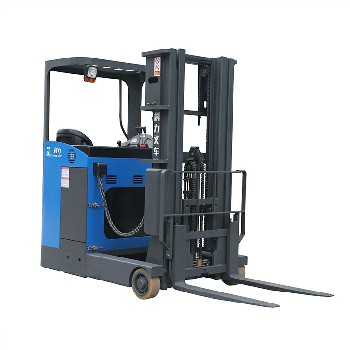
Applications of Pettibone Forklifts
Pettibone forklifts find applications in various industries and sectors, including:
Construction sites: Handling heavy construction materials, loading and unloading trucks, and working at heights with the help of telehandlers.
Manufacturing facilities: Moving and organizing raw materials, finished products, and heavy machinery within factories.
Warehousing and logistics: Efficiently stacking and retrieving pallets, loading and unloading shipments, and navigating tight spaces in warehouses.
Mining and extraction: Transporting large quantities of materials in mining operations, including in rugged terrains.
Maintenance and Safety Considerations
To ensure the longevity and safe operation of Pettibone forklifts, regular maintenance is essential. This includes routine inspections, lubrication, and timely servicing of components. Operators should also follow safety protocols, undergo proper training, and be aware of load capacity limits and safe operating procedures.
Comparing Pettibone Forklifts with Other Brands
When considering heavy load handling equipment, it is important to evaluate different brands and models. While Pettibone forklifts have their unique features and advantages, it is advisable to compare them with other reputable brands to make an informed decision based on your specific requirements.
Cost Analysis: Investing in a Pettibone Forklift
The cost of a Pettibone forklift can vary depending on the model, specifications, and additional features. It is crucial to consider the initial purchase cost, long-term maintenance expenses, and the return on investment that the forklift can provide through increased productivity and operational efficiency.
Training and Certification for Operating Pettibone Forklifts
Operating a Pettibone forklift requires proper training and certification to ensure safe and competent operation. Training programs are available through authorized Pettibone dealers or specialized training institutions. These programs cover essential operating skills, safety protocols, and maintenance procedures.
Future Trends in Pettibone Forklift Technology
As technology continues to advance, the future of Pettibone forklifts is likely to see further improvements. Some potential trends include:
Integration of advanced telematics for real-time monitoring of machine performance and predictive maintenance.
Enhanced automation features for improved efficiency and reduced operator fatigue.
Integration with digital platforms and systems for seamless data management and inventory tracking.
Where to Buy pettibone forklifts?
Jiangsu Kinlift equipment., Ltd. is at Jiepai Town, Danyang city, 212323, PRC., which is situated on the bank of the Yangtze River.
Kinlift is an equipment manufacturer specializing in electric warehousing forklift and committed to research & development, production, sales of light & compact warehousing transport vehicles, offers the customers the optimal solutions of the special material handling, transport, stacking. The product range of Kinlift is as below: Electric Pallet Trucks, Fully Electric Stackers, Semi-electric Stackers,Electric Reach Forklifts, Electric Counterbalanced Forklifts, Electric Tow Tractors, Order Pickers, as well as some other customized products in terms of the customers’ requirements. Our products are applicable to numerous industries of manufacturing, logistics, architecture, military industry, pharmaceuticals, food, chemical industry, electronics, machinery, furniture, textile industry, metallurgy, energy industry and so on.You can contact us to inquire about pettibone forklift
READ MORE -
Tow Tractors: Efficient Material Handling SolutionsJune 26, 2023
What are Tow Tractors?
Tow tractors, also known as tugger trucks or burden carriers, are electric or diesel-powered vehicles designed to tow heavy loads. They feature a compact size, maneuverability, and a towing hitch or coupling mechanism for connecting trailers, carts, or other types of material handling equipment. Tow tractors are commonly used in warehouses, manufacturing facilities, distribution centers, airports, and other settings where the movement of heavy loads is required.
Types of Tow Tractors
There are several types of tow tractors available, including:
Electric Tow Tractors: These tow tractors are powered by electric batteries and are suitable for indoor applications where low noise levels and zero emissions are desired.
Diesel Tow Tractors: Diesel tow tractors are powered by diesel engines, providing high torque and the ability to operate in outdoor environments and on rough terrain.
Tow Tractor with Operator Platform: Some tow tractors feature an operator platform, allowing the driver to ride on the vehicle for increased visibility and control.
Tow Tractor without Operator Platform: These tow tractors are operated by walking alongside or behind the vehicle and are ideal for applications where space is limited.
Applications of Tow Tractors
Tow tractors find extensive applications in various industries, including:
Warehousing and Distribution: Tow tractors are commonly used for transporting pallets, bins, or carts loaded with goods within warehouses and distribution centers.
Manufacturing Facilities: They facilitate the movement of raw materials, components, or finished products between different production areas in manufacturing plants.
Airports and Seaports: Tow tractors are utilized for towing baggage carts, cargo trailers, or other equipment in airports and seaports.
Hospitality and Retail: Tow tractors are employed in hotels, resorts, or retail stores to transport goods, luggage, or laundry carts.
Automotive Industry: They play a significant role in automobile manufacturing and assembly lines, moving vehicle components and facilitating the production process.
Benefits of Using Tow Tractors
Using tow tractors in material handling operations offers several benefits, including:
Increased Efficiency: Tow tractors enable the simultaneous transportation of multiple loads, reducing the number of trips required and enhancing productivity.
Improved Safety: These vehicles are designed with safety features, such as brakes, lights, and warning signals, ensuring safe operation and reducing the risk of accidents.
Flexibility and Maneuverability: Tow tractors are compact and agile, allowing them to navigate narrow aisles, tight corners, and crowded spaces with ease.
Cost Savings: By efficiently moving heavy loads, tow tractors minimize the need for manual labor and reduce operational costs associated with material handling.
Versatility: With various hitching options and compatibility with different attachments, tow tractors can adapt to a wide range of material handling tasks.
Factors to Consider When Choosing a Tow Tractor
When selecting a tow tractor for your specific needs, consider the following factors:
Load Capacity: Assess the maximum load capacity required to ensure the tow tractor can handle the weight of your intended loads.
Operating Environment: Consider the surface conditions, terrain, and whether the vehicle will be used indoors or outdoors to determine the appropriate type of tow tractor.
Battery Life and Charging: If opting for an electric tow tractor, evaluate the battery life and charging capabilities to ensure uninterrupted operation.
Maneuverability: Evaluate the turning radius, speed control, and overall maneuverability of the tow tractor to match your facility's layout and operational requirements.
Operator Comfort and Safety: Look for features such as ergonomic seating, adjustable controls, and safety features to ensure operator comfort and minimize fatigue.
Maintenance and Care for Tow Tractors
Proper maintenance and care are essential for the longevity and optimal performance of tow tractors. Consider the following tips:
Regular Inspections: Conduct routine inspections of the vehicle, checking for any signs of wear, loose components, or potential issues.
Scheduled Servicing: Follow the manufacturer's recommended service schedule for tasks such as oil changes, filter replacements, and battery maintenance.
Cleaning and Lubrication: Keep the tow tractor clean and lubricate moving parts regularly to prevent corrosion and ensure smooth operation.
Operator Training: Provide comprehensive training to operators on the proper use, safety protocols, and maintenance procedures of the tow tractor.
Conclusion
Tow tractors are efficient material handling solutions used across various industries to transport heavy loads. By understanding their functionality, types, applications, benefits, factors to consider when choosing one, and maintenance requirements, you can make informed decisions and effectively integrate tow tractors into your material handling operations.
China Towing Tractor Manufacturer
Jiangsu Kinlift equipment., Ltd. is at Jiepai Town, Danyang city, 212323, PRC., which is situated on the bank of the Yangtze River.Kinlift is an equipment manufacturer specializing in electric warehousing forklift and committed to research & development, production, sales of light & compact warehousing transport vehicles, offers the customers the optimal solutions of the special material handling, transport, stacking. professional Battery Powered Forklift manufacturer in China, please contact us now. We provide professional products and first-class service.
READ MORE -
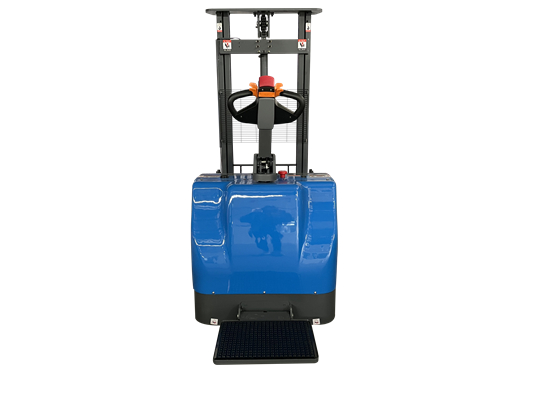 Battery Powered Pallet Stackers: Advantages and ApplicationsJune 19, 2023
Battery Powered Pallet Stackers: Advantages and ApplicationsJune 19, 2023About Battery Powered Pallet Stackers:
1. Introduction of Battery-powered pallet stackers
Battery-powered pallet stackers, also known as electric stackers, are material handling equipment designed to lift and transport pallets and other heavy loads. These stackers utilize battery power to operate, providing a range of benefits compared to traditional manual or gas-powered alternatives.
2. Advantages of Battery Powered Pallet Stackers
a) Increased Efficiency and Productivity
One of the key advantages of battery-powered pallet stackers is their ability to enhance efficiency and productivity in warehouse operations. These stackers feature electric motors that provide smooth and precise movements, allowing for quicker and more accurate positioning of loads. With battery-powered stackers, operators can handle multiple tasks efficiently, reducing the time and effort required for manual operations.
b) Versatility and Maneuverability
Battery-powered pallet stackers are designed with maneuverability in mind. They offer excellent control and maneuvering capabilities, making them suitable for navigating narrow aisles and tight spaces. Their compact size and ergonomic design allow operators to easily maneuver in crowded warehouse environments, optimizing space utilization and enhancing overall workflow.
c) Improved Safety
Safety is a top priority in material handling operations, and battery-powered pallet stackers contribute to a safer working environment. These stackers are equipped with safety features such as anti-roll-back mechanisms, overload protection, and emergency stop buttons. Additionally, the absence of exhaust emissions in battery-powered stackers eliminates the risks associated with gas-powered equipment, ensuring cleaner air quality for operators and reducing the potential for accidents.
d) Cost Savings
While the initial cost of battery-powered pallet stackers may be higher compared to manual or gas-powered alternatives, they offer long-term cost savings. Battery-powered stackers require less maintenance and have lower operating costs. They eliminate the need for fuel, oil changes, and regular maintenance associated with gas-powered equipment. Moreover, their energy-efficient electric motors consume less power, resulting in reduced energy costs over time.
3. Applications of Battery Powered Pallet Stackers
Battery-powered pallet stackers find applications in various industries, including:
Warehousing and Distribution: Battery-powered stackers are widely used in warehouses and distribution centers for loading and unloading pallets, organizing inventory, and optimizing storage space.
Manufacturing: These stackers are utilized in manufacturing facilities for handling raw materials, moving finished products, and assisting in assembly line operations.
Retail: Battery-powered pallet stackers play a crucial role in retail environments, enabling efficient stock replenishment, order picking, and display setup.
Logistics and Freight: In the logistics and freight industry, battery-powered stackers aid in the movement of goods, both indoors and outdoors, contributing to streamlined operations and improved supply chain management.
Agriculture: Battery-powered stackers are employed in agricultural settings for tasks such as handling bulk bags of fertilizers or transporting harvested crops.
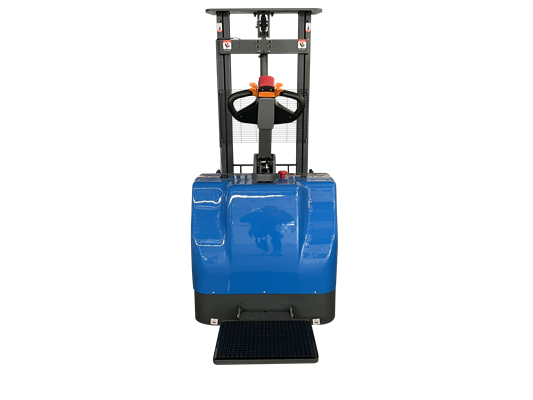
How long do the batteries last in battery-powered pallet stackers?
The battery life of a pallet stacker depends on various factors, including the type of battery, usage frequency, and load capacity. Generally, batteries can last for several hours on a single charge, and they can be recharged during breaks or overnight.
Can battery-powered stackers handle heavy loads?
Yes, battery-powered pallet stackers are designed to handle heavy loads. They have different load capacities, and it's important to select a stacker that suits the weight requirements of your specific application.
What maintenance is required for battery-powered pallet stackers?
Battery-powered stackers require regular maintenance, including battery charging, cleaning, and inspections. It's essential to follow the manufacturer's guidelines for maintenance and ensure that the batteries are properly maintained and replaced when necessary.
Can battery-powered stackers be used outdoors?
While battery-powered stackers are primarily designed for indoor use, some models are suitable for limited outdoor applications. It's important to check the manufacturer's specifications to determine if the stacker is suitable for outdoor use and the specific environmental conditions it can handle.
Where can I purchase battery-powered pallet stackers?
Battery-powered pallet stackers are available from various material handling equipment suppliers, both online and offline. It's recommended to research reputable suppliers and compare different models to find the stacker that best meets your requirements.Contact us!
In conclusion, battery-powered pallet stackers offer significant advantages in terms of efficiency, maneuverability, safety, and cost savings. Their applications span across industries, making them an essential tool for various material handling operations. By investing in battery-powered pallet stackers, businesses can improve productivity, enhance workflow, and optimize their material handling processes.
READ MORE -
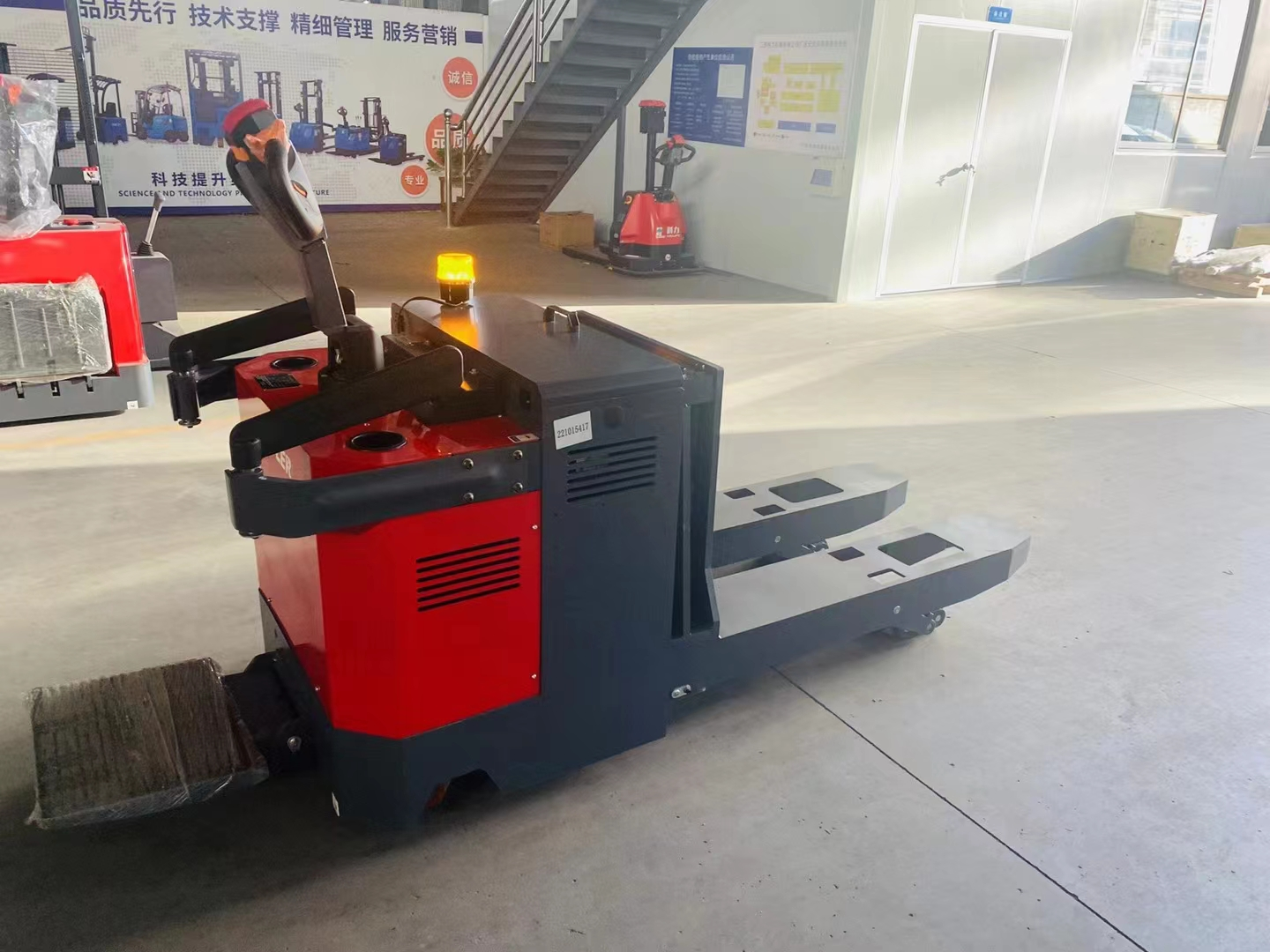 Order Picker Forklift: Enhancing Efficiency and Productivity in Material Handling OperationsJune 12, 2023
Order Picker Forklift: Enhancing Efficiency and Productivity in Material Handling OperationsJune 12, 2023What is an Order Picker Forklift?
An order picker forklift, also known as an order selector or stock picker, is a type of forklift specifically designed for order picking operations. Unlike traditional forklifts, which are primarily used for lifting and transporting pallets, order picker forklifts are equipped with platforms or cages that allow operators to elevate themselves to the required height to pick products from storage racks or shelves.
Types of Order Picker Forklifts
Low-level Order Picker Forklifts
Low-level order picker forklifts are commonly used in warehouses and distribution centers with lower ceiling heights. These forklifts are typically designed with a platform that can be raised and lowered to allow operators to access products at lower heights easily. They are ideal for picking items from ground-level storage areas and can handle medium-sized loads.
High-level Order Picker Forklifts
High-level order picker forklifts are suitable for warehouses and distribution centers with higher ceiling heights. These forklifts feature an extendable mast that allows operators to reach elevated storage racks and shelves. They provide enhanced versatility and can handle larger loads, making them ideal for high-volume order picking operations.
Key Features and Benefits of Order Picker Forklifts
Increased Efficiency and Productivity
Order picker forklifts significantly improve the efficiency and productivity of order picking tasks. By eliminating the need for manual picking or using ladders, operators can access products quickly, reducing the time spent on each pick. The elevated platforms or cages provide a stable and secure working area, enabling operators to work efficiently at various heights.
Versatility and Maneuverability
Order picker forklifts are designed to maneuver through narrow aisles and tight spaces, maximizing the utilization of available storage space. With their compact size and precise control, these forklifts can navigate around obstacles, making them ideal for confined environments. Their versatility allows operators to handle a wide range of products, contributing to improved workflow and operational flexibility.
Enhanced Safety Features
Safety is a paramount concern in material handling operations, and order picker forklifts are equipped with various safety features to ensure the well-being of operators and protect the integrity of products. These features may include non-slip platforms, guardrails, anti-roll-back systems, emergency stop buttons, and safety harnesses. The incorporation of such safety measures reduces the risk of accidents, promoting a safe working environment.
Applications of Order Picker Forklifts
Order picker forklifts find applications in diverse industries and settings. Here are a few examples:
Warehouses and Distribution Centers
In large-scale warehouses and distribution centers, order picker forklifts play a crucial role in order fulfillment processes. Operators can efficiently pick products from different locations and transport them to staging areas or loading docks, ensuring accurate and timely order processing.
Retail Stores
Retail stores often utilize order picker forklifts to restock shelves or retrieve products stored at higher levels. These forklifts enable store personnel to replenish inventory quickly, maintain organized displays, and enhance the overall shopping experience for customers.
Manufacturing Facilities
Within manufacturing facilities, order picker forklifts assist in material handling tasks, such as moving components, tools, and finished products. Their versatility allows for efficient movement of items between production lines, storage areas, and shipping docks, contributing to streamlined manufacturing processes.
Factors to Consider When Choosing an Order Picker Forklift
When selecting an order picker forklift for your specific application, several factors should be taken into account:
Lift Height and Capacity
The lift height and capacity requirements depend on the height of the storage racks or shelves in your facility and the average weight of the products being handled. It is essential to choose a forklift that can reach the required heights and handle the maximum load without compromising safety or efficiency.
Power Source
Order picker forklifts are available in different power options, including electric, propane, and diesel. Electric forklifts are popular due to their eco-friendliness, low noise levels, and reduced maintenance requirements. However, propane and diesel forklifts are better suited for outdoor applications or environments with limited charging infrastructure.
Operator Comfort and Ergonomics
To ensure operator comfort and reduce fatigue during extended shifts, consider forklifts that offer ergonomic features such as adjustable seats, intuitive controls, and ample legroom. Comfortable operators are more productive and less prone to errors or accidents.
Maintenance and Serviceability
Evaluate the maintenance requirements and serviceability of the forklift models you are considering. Look for forklifts with easily accessible components, user-friendly diagnostic systems, and reliable after-sales support. Regular maintenance and prompt repairs are essential for maximizing uptime and prolonging the lifespan of your equipment.
Best Practices for Operating an Order Picker Forklift
To ensure safe and efficient operation of an order picker forklift, follow these best practices:
Proper Training and Certification
Operators should receive comprehensive training on operating order picker forklifts, including safety protocols, equipment controls, load handling techniques, and emergency procedures. Certification programs are available to validate the operator's competence and compliance with industry standards.
Pre-operation Inspections
Before each shift, conduct pre-operation inspections to identify any potential issues or safety concerns. Check the forklift's tires, brakes, hydraulics, lights, and controls to ensure everything is in proper working order. Any defects or malfunctions should be reported and addressed promptly.
Load Handling Techniques
Proper load handling techniques are crucial to maintain stability and prevent accidents. Ensure that loads are balanced, properly secured, and within the forklift's rated capacity. Follow recommended stacking heights and never exceed the forklift's lifting limitations.
Safe Operating Practices
Observe safe operating practices at all times. Adhere to speed limits, yield to pedestrians, and maintain a safe distance from other forklifts or obstacles. Use horn signals or flashing lights to alert others of your presence and always be aware of your surroundings.
Maintenance and Servicing of Order Picker Forklifts
Regular maintenance and servicing are essential for the optimal performance and longevity of order picker forklifts. Here are some key considerations:
Regular Inspections and Preventive Maintenance
Implement a regular inspection schedule to identify any signs of wear, damage, or potential issues. Inspect components such as tires, forks, chains, hydraulics, and electrical systems. Perform routine maintenance tasks, such as lubrication, filter changes, and battery checks, according to the manufacturer's recommendations.
Battery and Charger Maintenance
If using electric order picker forklifts, proper battery maintenance is crucial. Follow recommended charging and discharging practices, monitor battery fluid levels, and perform regular cleaning to ensure efficient and reliable performance. Inspect chargers for any defects or malfunctions and address them promptly.
Repairs and Replacement Parts
Address any issues or malfunctions promptly by seeking professional repairs or replacement parts from authorized service providers. Using genuine parts and qualified technicians ensures the integrity and safety of your forklift, minimizing downtime and costly repairs in the long run.
Conclusion
Order picker forklifts are indispensable tools for efficient order picking and material handling operations. With their specialized features, increased productivity, versatility, and enhanced safety, these forklifts play a vital role in warehouses, distribution centers, and manufacturing facilities. By considering the specific requirements of your operation and adhering to best practices for operation and maintenance, you can optimize the performance of your order picker forklifts and achieve greater efficiency in your material handling processes.
FAQs
How does an order picker forklift differ from other types of forklifts?
Order picker forklifts are specifically designed for order picking tasks and feature platforms or cages for operators to elevate themselves. In contrast, other forklifts primarily focus on lifting and transporting pallets.
What safety features should I look for in an order picker forklift?
Important safety features to consider include non-slip platforms, guardrails, anti-roll-back systems, emergency stop buttons, and safety harnesses.
Can order picker forklifts be used outdoors?
While some order picker forklifts are suitable for outdoor use, it depends on the specific model and its power source. Electric forklifts are generally more suited for indoor applications.
Are there any regulations or certifications required to operate an order picker forklift?
Regulations may vary by jurisdiction, but operators typically require proper training and certification to operate an order picker forklift. Certification programs are available to ensure compliance with safety standards.
How often should an order picker forklift be serviced?
Regular maintenance and servicing should be performed according to the manufacturer's recommendations. Implementing a preventive maintenance schedule and addressing any issues promptly is crucial for optimal performance and longevity.
READ MORE -
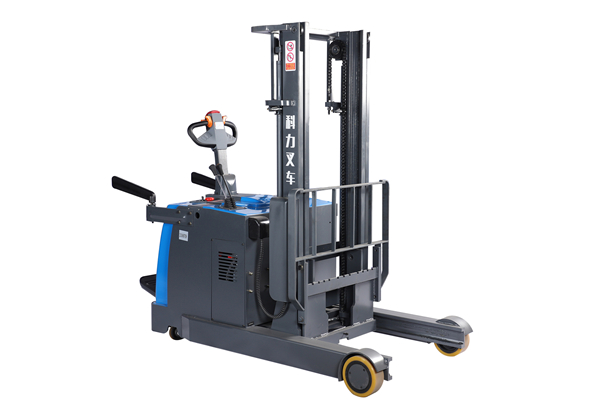 How Long Does Forklift Certification LastJune 05, 2023
How Long Does Forklift Certification LastJune 05, 2023How Long Does Forklift Certification Last?
Introduction
When it comes to operating forklifts, safety is of utmost importance. Forklift certification ensures that operators are trained to handle these powerful machines in a safe and responsible manner. If you're considering a career or job that involves operating a forklift, you may wonder how long the certification lasts and what steps are involved in maintaining it. In this article, we'll explore the duration of forklift certification, factors that affect its validity, and the importance of staying certified.
What is Forklift Certification?
Before diving into the duration of forklift certification, let's understand what it entails. Forklift certification is a process that provides operators with the necessary knowledge and skills to safely operate forklifts. It typically involves a combination of classroom training and practical evaluations. By obtaining certification, operators demonstrate their competence and understanding of forklift operations, load handling, and safety protocols.
Importance of Forklift Certification
Forklift certification holds immense importance in ensuring workplace safety. Operating a forklift without proper training and certification can lead to accidents, injuries, and even fatalities. Certified forklift operators possess the skills to maneuver the equipment efficiently, understand load capacities, and follow safety guidelines. Their training covers areas such as pre-operation inspections, load stability, and safe driving practices. By obtaining certification, operators contribute to a safer work environment for themselves and their colleagues.
How Long Does Forklift Certification Last?
The duration of forklift certification can vary based on several factors. Generally, forklift certifications are valid for a specific period, after which operators are required to renew their certification to stay compliant. While the exact duration may vary, the typical validity of forklift certification ranges from three to five years.
Factors Affecting the Duration of Forklift Certification
Several factors can influence how long a forklift certification remains valid. These factors may include:
1. Local Regulations
Different regions or countries may have their own regulations and standards regarding forklift certification duration. It's important to be aware of the specific requirements in your area.
2. Employer Policies
Employers may have their own policies regarding forklift certification renewal. Some companies may choose to renew certifications more frequently to ensure the highest level of safety in their operations.
3. Changes in Regulations
Regulations regarding forklift operations and certifications can change over time. It's essential for operators to stay updated with any new requirements or guidelines that may impact the duration of their certification.
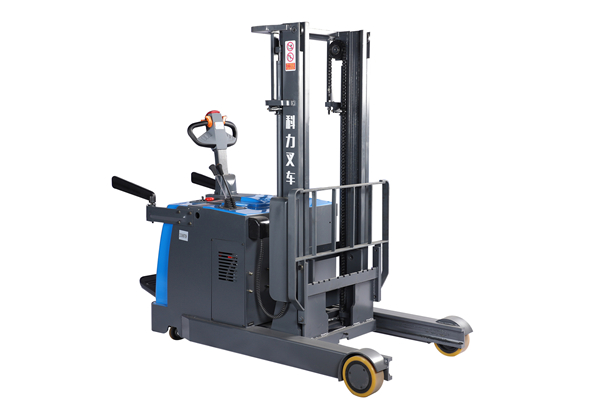
OSHA Regulations on Forklift Certification Duration
In the United States, the Occupational Safety and Health Administration (OSHA) sets standards for forklift certification and workplace safety. According to OSHA, forklift certifications must be renewed every three years to ensure operators are up to date with the latest safety practices and regulations.
OSHA also requires employers to provide refresher training to forklift operators in specific situations. These situations include when an operator is observed operating unsafely, involved in an accident or near-miss incident, assigned to a different type of forklift, or when workplace conditions change that could affect safe operation.
Renewing Forklift Certification
To renew forklift certification, operators must undergo a renewal process that includes both theoretical and practical assessments. The exact requirements may vary depending on local regulations and employer policies. Typically, the renewal process involves a review of forklift operations, safety guidelines, and an evaluation of the operator's skills and knowledge.
Benefits of Regularly Renewing Forklift Certification
Renewing forklift certification on a regular basis offers several benefits. These include:
Enhanced Safety: Regular training and certification renewal ensure operators stay updated with the latest safety practices, reducing the risk of accidents and injuries in the workplace.
Improved Efficiency: Renewal training provides operators with an opportunity to refresh their knowledge and skills, leading to increased efficiency in forklift operations.
Compliance: By renewing their certification, operators remain compliant with local regulations and employer requirements.
Career Advancement: Having an up-to-date forklift certification can open doors to better job opportunities and career advancement within the material handling industry.
Forklift Certification Expiry and Consequences
Allowing forklift certification to expire can have serious consequences. Operating a forklift without a valid certification not only puts the operator at risk but also jeopardizes the safety of everyone in the vicinity. Furthermore, non-compliance with forklift certification requirements can result in legal penalties, workplace accidents, and damaged employer reputation. It is crucial for operators to prioritize certification renewal to maintain a safe work environment.
Best Practices for Maintaining Forklift Certification
To ensure the longevity of forklift certification and promote workplace safety, operators should consider the following best practices:
Stay Informed: Keep yourself updated with the latest regulations and guidelines regarding forklift operations and certification renewal.
Regular Training: Participate in regular training sessions and refresher courses to enhance your knowledge and skills.
Safety Culture: Promote a safety culture in the workplace by adhering to safety protocols, reporting any issues, and encouraging colleagues to maintain valid certifications.
Record-Keeping: Maintain records of certification renewal dates, training sessions attended, and any additional qualifications acquired. This documentation can be valuable for both personal and professional purposes.
FAQs
Q1. Can I operate a forklift without certification?
Operating a forklift without proper certification is not recommended. It not only puts you at risk but also poses a threat to the safety of others. Forklift certification ensures you have the necessary knowledge and skills to operate the equipment safely.
Q2. How often should I renew my forklift certification?
The duration of forklift certification renewal may vary depending on local regulations and employer policies. In general, certifications are valid for three to five years. It's essential to stay updated with the specific requirements in your area.
Q3. What happens if my forklift certification expires?
Allowing your forklift certification to expire can have serious consequences. Operating a forklift without a valid certification not only puts you at risk but also violates safety regulations. It may lead to legal penalties, workplace accidents, and damage your employer's reputation.
Q4. Is forklift certification transferable between employers?
Forklift certification is typically not transferable between employers. Each employer may have their own policies and training requirements. When switching jobs, you may need to obtain certification according to your new employer's guidelines.
Q5. Can I renew my forklift certification online?
Yes, in many cases, you can renew your forklift certification online. There are various reputable online training providers that offer renewal courses. Ensure that the online course you choose is compliant with local regulations and meets the necessary standards.
READ MORE -
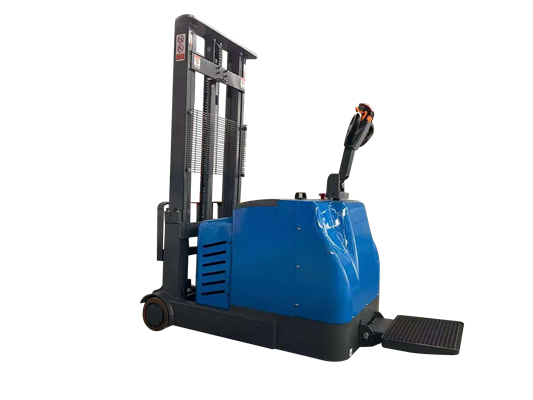 7 Different Types of ForkliftsMay 30, 2023
7 Different Types of ForkliftsMay 30, 2023The 7 Different Types Of Forklifts
If you’re looking at forklifts for sale, you may have seen descriptions such as: counterbalanced lift trucks (class 4) or electric-powered rider trucks (class 1) and wondered, “what the heck?”
OSHA’s classifications don’t always match the everyday terms we use. For example, what OSHA calls “class 4,” most people know as an internal combustion forklift with cushion tires.
Forklifts are essential tools in many industries and workplaces, but not all forklifts are the same. The Occupational Safety and Health Administration (OSHA) recognizes seven different types of forklifts, each with its own unique capabilities and uses.
Understanding the various types of forklifts is crucial when it comes to selecting the right one for a specific job or application. Each type has its own unique features, specifications, and capabilities.
In this article, we will discuss each type of forklift recognized by OSHA, their specifications, and their best uses to help you make informed decisions about which type of forklift is best suited for your workplace needs.
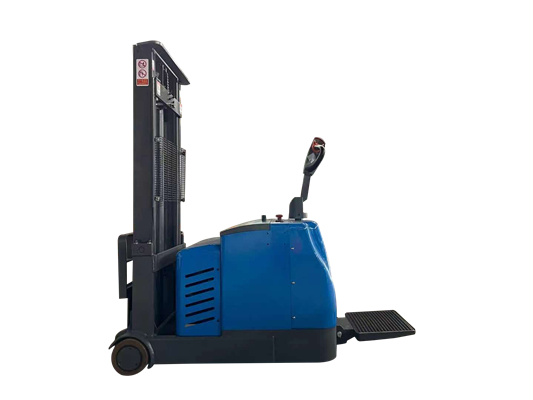
FORKLIFT TYPES AND OSHA CLASSIFICATIONS
OSHA’s forklift classification system includes forklifts and other powered lifting equipment such as:
Battery-powered (electric) forklifts
Internal combustion (IC) forklifts
Powered pallet jacks
Order pickers
Reach trucks
Tow Tractors
High-capacity forklifts
Rough terrain forklifts
But OSHA doesn’t use the descriptions above to classify forklifts. For example, IC-powered forklifts are divided into two different classes, one for cushion tires and one for pneumatic. Electric forklifts are also broken into two classes but not based upon tire type.
THE 7 OSHA FORKLIFT CLASSIFICATIONS
Forklifts play a crucial role in various industries, allowing for efficient material handling and streamlining operations. However, operating a forklift comes with inherent risks, which is why the Occupational Safety and Health Administration (OSHA) has established a comprehensive classification system for forklifts. Understanding the OSHA forklift classifications is vital for both operators and employers to ensure safety, efficiency, and compliance with regulations.
Introduction
Operating a forklift requires specific skills and knowledge, and OSHA forklift classifications help categorize different types of forklifts based on their characteristics and capabilities. By classifying forklifts into distinct classes, OSHA provides guidelines for training, certification, and safety requirements. Let's explore the seven OSHA forklift classifications and gain a deeper understanding of each class.
Class I: Electric Motor Rider Trucks
Class I forklifts are electric motor rider trucks designed for applications that require indoor use, such as warehouses and manufacturing facilities. These forklifts are powered by industrial batteries and offer emission-free operation, making them ideal for environments where air quality is a concern. Class I forklifts come in various subtypes, including counterbalanced sit-down riders, stand-up riders, and three-wheel electric forklifts.
Electric motor rider trucks provide excellent maneuverability, stability, and lifting capacities, making them suitable for handling heavy loads. Their electric power source ensures quiet operation and reduces maintenance requirements. Class I forklifts are highly versatile and can handle a wide range of materials, making them a popular choice in many industries.
Class II: Electric Motor Narrow Aisle Trucks
Class II forklifts, also known as electric motor narrow aisle trucks, are specifically designed for operating in tight spaces and narrow aisles. These forklifts are commonly used in warehouses with high-density storage systems. Class II forklifts are known for their maneuverability and ability to navigate narrow aisles while maintaining stability.
Electric motor narrow aisle trucks often feature specialized features like articulated steering or rotating masts, allowing operators to access materials in confined spaces with ease. These forklifts are typically operated by standing on a platform or utilizing a small cabin. Class II forklifts help maximize storage space utilization and enable efficient material handling in compact environments.
Class III: Electric Motor Hand Trucks or Hand/Rider Trucks
Class III forklifts are electric motor hand trucks or hand/rider trucks, commonly referred to as pallet jacks or pallet trucks. These forklifts are primarily used for horizontal transportation of loads, typically on pallets. Class III forklifts are operated by walking behind or standing on the vehicle while controlling its movement.
Electric motor hand trucks offer increased productivity and reduced physical strain for operators. They are widely utilized in retail, distribution centers, and manufacturing facilities for tasks such as loading and unloading trucks, transporting goods, and organizing inventory. Class III forklifts are available in both manual and electric-powered variants, providing flexibility to match specific operational requirements.
Class IV: Internal Combustion Engine Trucks (Solid/Cushion Tires)
Class IV forklifts are internal combustion engine trucks equipped with solid or cushion tires. These forklifts are designed for indoor use on smooth, paved surfaces. The solid or cushion tires eliminate the risk of punctures and provide better stability on even floors, making them suitable for warehouses and manufacturing facilities.
Internal combustion engine trucks with solid/cushion tires are available in various configurations, including sit-down riders and stand-up riders. They are powered by gasoline, propane, or diesel engines, providing higher lifting capacities compared to electric forklifts. Class IV forklifts are commonly used for loading and unloading materials from trucks and transporting loads within indoor facilities.
Class V: Internal Combustion Engine Trucks (Pneumatic Tires)
Class V forklifts are internal combustion engine trucks equipped with pneumatic tires. Unlike Class IV forklifts, which are designed for indoor use, Class V forklifts are suitable for both indoor and outdoor applications. The pneumatic tires provide excellent traction and shock absorption, enabling these forklifts to operate on uneven or rough terrain.
Internal combustion engine trucks with pneumatic tires offer higher ground clearance and enhanced stability on outdoor surfaces. They are commonly utilized in construction sites, lumber yards, and other outdoor environments where rough terrain is present. Class V forklifts are available in various configurations, including sit-down riders and stand-up riders, providing versatility for different applications.
Class VI: Electric and Internal Combustion Engine Tractors
Class VI forklifts encompass electric and internal combustion engine tractors used primarily for towing and pulling heavy loads. These forklifts are designed to transport trailers, cargo, or other heavy equipment within facilities or across short distances. Class VI forklifts are available in both electric and internal combustion engine variants.
Electric and internal combustion engine tractors offer powerful towing capabilities, enabling efficient movement of heavy loads. They are commonly used in shipping yards, airports, and manufacturing plants. Class VI forklifts are equipped with features like fifth-wheel attachments or tow bars, allowing operators to connect and transport trailers safely.
Class VII: Rough Terrain Forklift Trucks
Class VII forklifts, known as rough terrain forklift trucks, are specifically designed for outdoor applications on rough and uneven terrain. These forklifts are commonly used in construction sites, lumber yards, and agricultural settings. Class VII forklifts excel in handling heavy loads in challenging environments.
Rough terrain forklift trucks are equipped with oversized, aggressive tires that provide excellent traction on unpaved surfaces. They also have a higher ground clearance to navigate uneven terrain comfortably. Class VII forklifts feature robust construction and powerful engines to handle demanding outdoor tasks, such as lifting construction materials, loading and unloading cargo from trucks, and transporting equipment.
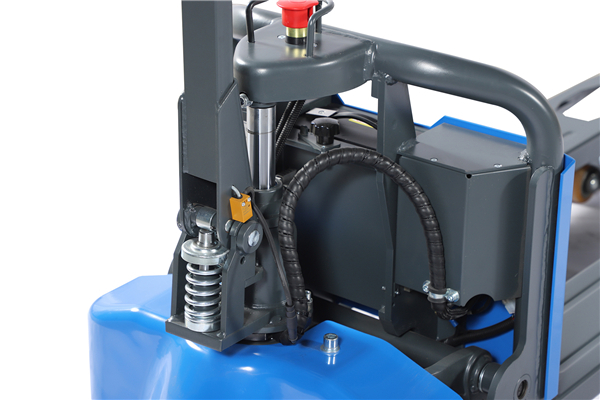
Conclusion
Understanding the seven OSHA forklift classifications is crucial for maintaining safety, ensuring compliance, and optimizing efficiency in material handling operations. Each class of forklifts serves specific purposes and comes with distinct capabilities. Employers must provide appropriate training and certification to forklift operators based on the specific class of forklift they will be operating.
By adhering to OSHA guidelines and ensuring operators are properly trained, employers can mitigate the risks associated with forklift operations and create a safer work environment. It is vital to prioritize the safety of both operators and those working in close proximity to forklifts.
Remember, proper training and certification, routine inspections, and adherence to safety protocols are key elements in preventing accidents and maintaining a productive workplace.
FAQs
What is the primary purpose of OSHA forklift classifications?
OSHA forklift classifications serve to categorize different types of forklifts based on their characteristics and capabilities. This classification system helps establish guidelines for training, certification, and safety requirements, ensuring proper handling and operation of forklifts.
Can forklift operators use the same certification for different classes of forklifts?
No, each class of forklift requires specific training and certification. Operators must receive training and certification for the particular class of forklift they will be operating to ensure they are knowledgeable about the specific requirements and safety considerations associated with that class.
Are there any age restrictions for operating certain forklift classes?
OSHA does not specify age restrictions for operating forklifts. However, employers must comply with applicable federal, state, and local regulations regarding the minimum age requirements for operating industrial equipment, including forklifts.
How often should forklift operators receive training and certification updates?
Forklift operators should receive training and certification updates at regular intervals, typically every three years or as required by OSHA regulations. Additionally, operators should receive refresher training if they are involved in an accident or observed operating a forklift unsafely.
Are there any specific safety guidelines for each forklift classification?
Yes, OSHA provides specific safety guidelines for each forklift classification. These guidelines address factors such as load capacity, stability, maintenance, operational limitations, and proper use of safety features. Employers and operators should familiarize themselves with these guidelines to ensure safe operation of forklifts.
FORKLIFT BUYING TIPS
Whether you’re buying your first forklift or just want to quickly narrow down your options, our experienced forklift experts are here to help.
If you’re not ready to connect with an equipment expert, start with our free guide: How To Choose the Best Forklift for Your Needs and Budget. Save time and buy with confidence when you know:
Key questions to help you avoid buying the wrong forklift
When to choose an electric vs. internal combustion forklift
What tires and attachments you may need
How to get the maximum forklift for your money
Important questions buyers forget to ask
Further Reading:
When To Buy an Electric vs. LP Gas Forklift
READ MORE -
Motorized Pallet Truck: Enhancing Efficiency and ProductivityMay 24, 2023
Motorized Pallet Truck: Enhancing Efficiency and Productivity
Introduction
In today's fast-paced industrial landscape, optimizing material handling processes is crucial for businesses to achieve efficiency and productivity. One such equipment that has revolutionized the way materials are transported within warehouses and distribution centers is the motorized pallet truck. In this article, we will explore the various aspects of motorized pallet trucks, including their benefits, types, working mechanisms, factors to consider when choosing one, safety considerations, maintenance tips, cost implications, popular brands, and more. So, let's dive in!
What is a Motorized Pallet Truck?
A motorized pallet truck, also known as a powered pallet jack or an electric pallet truck, is a versatile handling device used for moving palletized loads. It is equipped with an electric motor that enables it to lift and transport heavy loads with ease. Unlike manual pallet trucks that require physical effort from operators, motorized pallet trucks are powered, making them an efficient and ergonomic solution for material handling tasks.
Benefits of Motorized Pallet Trucks
Motorized pallet trucks offer several benefits, making them a valuable investment for businesses. Firstly, they enhance productivity by reducing the time and effort required to move heavy loads. The electric motor provides the necessary power to lift and transport materials smoothly, eliminating the strain on operators. This results in faster and more efficient operations.
Moreover, motorized pallet trucks contribute to a safer working environment. Their ergonomic design reduces the risk of operator fatigue, which can lead to accidents or injuries. Additionally, these trucks often come with built-in safety features such as anti-roll-back mechanisms and emergency stop buttons, further ensuring the well-being of workers.
Types of Motorized Pallet Trucks
There are different types of motorized pallet trucks available to cater to various material handling needs. The most common ones include:
Walkie Pallet Trucks: These are compact and maneuverable trucks designed for tight spaces. They are operated by an operator walking alongside the truck, controlling its movements.
Rider Pallet Trucks: Rider pallet trucks are larger and more powerful. They are designed for longer distances and can accommodate heavier loads. Operators ride on the truck while controlling its movements.
Counterbalance Pallet Trucks: Counterbalance pallet trucks are suitable for handling loads without a pallet or in confined spaces. They feature a counterbalance mechanism that eliminates the need for additional support.
How Motorized Pallet Trucks Work
Motorized pallet trucks operate on a simple yet efficient mechanism. They are equipped with forks to lift the pallet and load. The electric motor powers the hydraulic system, which raises and lowers the forks. The truck is controlled by an operator using a handle or control panel, allowing for precise movement and positioning of the load. Some advanced models may include additional features like adjustable forks or attachments for specialized tasks.
Factors to Consider When Choosing a Motorized Pallet Truck
When selecting a motorized pallet truck, several factors should be considered to ensure it meets the specific requirements of your operation. These factors include:
Load Capacity: Determine the maximum weight your truck needs to handle, considering both the load and the pallet.
Operating Environment: Consider the layout of your facility, including aisle width, flooring conditions, and any potential obstacles that may affect maneuverability.
Battery Life and Charging: Evaluate the battery life of the truck and the availability of charging stations. This is particularly important for multi-shift operations.
Ergonomics: Look for trucks with features that prioritize operator comfort and safety, such as adjustable handles, cushioned platforms, and intuitive controls.
China Towing Tractor Manufacturer
Jiangsu Kinlift equipment., Ltd. is at Jiepai Town, Danyang city, 212323, PRC., which is situated on the bank of the Yangtze River.Kinlift is an equipment manufacturer specializing in electric warehousing forklift and committed to research & development, production, sales of light & compact warehousing transport vehicles, offers the customers the optimal solutions of the special material handling, transport, stacking. professional Battery Powered Forklift manufacturer in China, please contact us now. We provide professional products and first-class service.
READ MORE
-
 Knowledge of Compact Electric Pallet JackDecember 26, 2022
Knowledge of Compact Electric Pallet JackDecember 26, 2022About pallet jack mover
A pallet jack mover is a device used to move and transport large, heavy items. It consists of a platform on wheels, usually made from steel and plastic, with handles for easy maneuvering. The platform is typically between 18" and 48" wide, allowing it to hold pallets of various sizes. Pallet jacks are commonly used in manufacturing and warehousing to move heavy loads around the facility. They are also used in other industries such as retail and construction, where they can be used to transport goods or materials to different locations. Pallet jacks are an economical and efficient way to move heavy items quickly and safely.
A Pallet Jack Mover is a useful tool for transporting and maneuvering heavy items such as pallets, crates and other items. It is designed to significantly reduce the amount of effort required to move heavy loads. The Pallet Jack Mover has a handle that is easy to grip, allowing the user to quickly and easily propel the item forward. Its large wheels provide stability and control when maneuvering around tight corners or over uneven surfaces. The mover also comes with an extendable arm, allowing the user to raise and lower the item without having to bend down. With this practical tool, users can easily transport items from one place to another in a safe and efficient manner.
READ MORE -
 Ordering guide for electric forkliftDecember 23, 2022
Ordering guide for electric forkliftDecember 23, 2022Precautions for using electric forklift
Using an electric forklift can be a great way to increase productivity, but it is important to take safety precautions while operating them. Here are some tips to keep in mind when using an electric forklift:
1. Inspect the forklift before each use and check for any signs of wear or damage. Make sure all parts of the machine are working properly and that all safety features are in place.
2. Wear protective gear such as a hard hat, safety glasses, and steel-toed shoes when operating the forklift.
3. Familiarize yourself with the controls and operation of the electric forklift before using it. If you are unsure of how to operate it, ask for help from a trained operator or supervisor.
4. Keep your hands and feet away from moving parts when operating the forklift.
5. When carrying loads, ensure that the weight is evenly distributed and that the load is not higher than the maximum capacity of the forklift.
6. Never allow passengers on the electric forklift - even if it is not moving - as this can put them at risk of injury or death in case of an accident or tipping over.
About electric sit down forklift
Electric sit down forklifts are a type of material handling equipment designed to help facilitate the movement of materials from one location to another. They are powered by an electric motor and feature an operator platform that allows the operator to sit down for long periods of time. They are ideal for warehouses, factories, and other areas where frequent lifting is necessary. Electric sit down forklifts are easy to maneuver and can provide a high level of safety and efficiency in any warehouse setting. They are also more environmentally friendly than other types of forklifts, as they do not create emissions or require the use of diesel fuel. Electric sit down forklifts are a great choice for any business looking to increase productivity while reducing costs.
An electric sit down forklift is a type of industrial vehicle used to move or lift materials and other items. It is built with a seat for a driver and utilizes an electric motor to power the lift mechanism. The operator sits in the seat and operates the forklift with hydraulic controls. Electric sit down forklifts are designed for use in narrow aisles and tight spaces, as well as for long-distance work. They can be used outdoors or indoors, depending on their power source. Electric sit down forklifts are safe, efficient, and cost-effective, making them an ideal choice for a wide range of applications.
About small electric forklift
A small electric forklift is a great solution for businesses that need to move items that are too large or heavy for manual handling. These machines are powered by an electric motor, making them more efficient and cost effective than traditional gasoline-powered forklifts. They are designed to be compact and lightweight, making them easy to maneuver in tight spaces. Small electric forklifts can lift up to 1,500 pounds and reach heights of six feet or more. They also come with safety features such as overload protection and anti-tipping bars. With their low maintenance costs and easy operation, small electric forklifts are an excellent choice for businesses that need to move materials quickly and safely.
Small electric forklifts are an essential tool for a variety of businesses. They help to increase productivity, reduce labor costs and make everyday tasks easier. These units are powered by a battery and are easy to operate and maneuver in tight spaces. They have a low center of gravity and are designed to lift loads up to 3,000 lbs., making them perfect for small warehouses and manufacturing facilities. Small electric forklifts can be used indoors or outdoors with minimal noise, making them the best choice for working in confined areas or quiet environments. With their compact size, they require less space than diesel or gasoline powered models, while still offering the same level of performance. They also require minimal maintenance and come with a variety of safety features, such as warning lights and seatbelts, that help to ensure the safety of operators.
READ MORE -
 Fields Of Application Of Autonomous ForkliftDecember 13, 2022READ MORE
Fields Of Application Of Autonomous ForkliftDecember 13, 2022READ MORE -
 Wide Application Of Pallet Stacker TruckNovember 28, 2022READ MORE
Wide Application Of Pallet Stacker TruckNovember 28, 2022READ MORE -
 Simple Application Of Three Wheel ForkliftNovember 24, 2022
Simple Application Of Three Wheel ForkliftNovember 24, 2022Maintenance method of Three Wheel Forklift
The three wheel forklift is a versatile and powerful tool that can be used in a variety of settings, from warehouses to construction sites. And while it’s a rugged and durable piece of equipment, it still needs regular maintenance to keep it running smoothly.
The three wheel forklift is one of the most versatile pieces of equipment in a warehouse or distribution center. But like any other piece of machinery, it needs to be properly maintained to ensure peak performance and longevity.
1. Check the tires regularly. The tires on a three wheel forklift take a lot of abuse, so they need to be checked frequently for wear and tear.
2. Inspect the forks. The forks are the most important part of the lift, so they need to be inspected regularly for damage or wear and tear.
3. Check the chains. The chains that connect the forks to the carriage can become stretched or damaged over time, so they need to be checked regularly as well.
4. Lubricate all moving parts. All of the moving parts on a three wheel forklift need to be lubricated regularly to prevent premature wear and tear.
5. Keep it clean. A dirty forklift can cause all sorts of problems, so it’s important to keep it clean both inside.
READ MORE -
 Applications Of Powered Pallet StackerNovember 21, 2022
Applications Of Powered Pallet StackerNovember 21, 2022Powered Pallet Stacker maintenance method
Powered pallet stackers make lifting and stacking heavy loads easier and safer for workers. But like any piece of material handling equipment, they require regular maintenance to keep them running properly. Here are a few tips on how to maintain your powered pallet stacker:
1. Check the tires regularly. Flat spots or cracks can form on the tires, which can cause the stacker to vibrate and shake when in use.
2. Inspect the chains and sprockets regularly. Look for signs of wear or damage, and replace any damaged parts as soon as possible.
3. Keep the battery charged. A powered pallet stacker will not run without a properly charged battery, so be sure to keep it topped off.
4. Follow the manufacturer’s recommendations for maintenance and service. This will help ensure that your stacker is always running at peak performance.
Powered pallet stackers are an important part of any business that uses them. By keeping them maintained, you can avoid costly repairs and downtime.
READ MORE -
 Electrical Forklift User GuideNovember 15, 2022
Electrical Forklift User GuideNovember 15, 2022Advantages of Electrical Forklift
An electric forklift is a battery-operated lift truck used to move materials around a warehouse, distribution center, or other industrial setting. Electric forklifts are powered by lead-acid batteries, which make them much quieter than their gasoline-powered counterparts. Additionally, electric forklifts generate no emissions, making them a more environmentally friendly option than other types of lift trucks.
There are many advantages to using an electric forklift over other types of lift trucks. Perhaps the most obvious advantage is that electric forklifts are more environmentally friendly than their gasoline-powered counterparts. Electric forklifts also tend to be quieter than gasoline-powered lift trucks, which can be beneficial in noisy warehouse environments. Additionally, electric forklifts require less maintenance than gasoline-powered lift trucks and can provide smoother operation.
Here are some of the advantages of electrical forklifts:
1. They're much quieter than diesel or gasoline forklifts, which is a big advantage in noise-sensitive environments.
2. They don't produce any emissions, so they're better for the environment.
3. They're more efficient and use less energy, which can save you money in the long run.
4. They require less maintenance than diesel or gasoline forklifts, so you'll save money there as well.
5. They have a smaller footprint and are more maneuverable, which is helpful in tight spaces.
READ MORE -
 A guide on electric lift pallet jackNovember 04, 2022
A guide on electric lift pallet jackNovember 04, 2022Precautions for electric lift pallet jack
If you're in the business of transporting or moving heavy loads, you know that the task can be physically demanding and time-consuming. This is where electric lift pallet jacks can make a huge difference. With their advanced technology, these machines not only save time and effort but also prevent injuries and accidents caused by manual lifting. However, using an electric lift pallet jack requires proper training and knowledge about its features and functions. In this guide, we'll provide all the essential information you need to operate an electric lift pallet jack safely and effectively. From its types and components to its maintenance and troubleshooting, we've got you covered. So, let's get started!
Electric lift pallet jacks have become a popular tool in many industries. With their ability to lift heavy loads with ease and maneuverability, they are essential equipment for warehouses, factories, and distribution centers. However, if you are new to the world of material handling equipment, it can be challenging to choose the right electric lift pallet jack for your needs. That's why we have put together this comprehensive guide on electric lift pallet jacks. In this blog, we will cover everything you need to know about electric lift pallet jacks, from their features to maintenance tips, to help you make an informed decision when buying and using one. So, let's dive in!
safety
When it comes to electric lift pallet jacks, there are a few key things you can do to help ensure safety in your workplace. Here are a few tips:
1. Make sure that your employees are properly trained on how to use the electric lift pallet jack. This includes understanding how to operate the controls, as well as how to safely load and unload items from the pallet.
2. Inspect the electric lift pallet jack before each use. This includes checking the tires, brakes, and controls to make sure they are all in good working order.
3. Never allow anyone to ride on the electric lift pallet jack while it is in use. This is extremely dangerous and could result in serious injury or death.
4. When not in use, always store the electric lift pallet jack in a safe and secure area to prevent unauthorized use or tampering.
Common faults and solutions of electric lift pallet jack
If you are a business that uses electric lift pallet jacks, then you know there are many benefits to using them. They help improve worker productivity, they improve safety, and they reduce the amount of time it takes to complete tasks. However, like all machinery, electric lift pallet jacks can have their faults. In this article, we will go over some of the most common faults of electric lift pallet jacks and what you can do to fix them.
1. The electric lift pallet jack will not move when the trigger is pulled.
This is usually due to a problem with the battery. Check to see if the battery is properly charged and if it is, try replacing it with a new one. If the problem persists, there may be an issue with the motor or controller.
2. The electric lift pallet jack moves very slowly or not at all when moving up an incline.
There are several possible causes for this issue:
-The battery may not be properly charged
-The load on the pallet jack may be too heavy
-There may be something blocking the wheels
-The
1. Check if the power indicator is on when the switch is turned on, and whether the motor works normally when it is turned on. If not, check whether the circuit breaker or fuse in the control box has burned out.
2. Check if there is something wrong with the push-button switch or wiring.
3. Check whether the pressure relief valve of the hydraulic system is normal, and whether there is oil leakage in all parts of the hydraulic system.
4. Check if there is something wrong with chain or chain wheel.
READ MORE -
 Application of stacking pallet jackNovember 03, 2022
Application of stacking pallet jackNovember 03, 2022Precautions for the use of stacker trucks
If you're using a stack pallet jack, there are a few things you should keep in mind. First, make sure the load is evenly distributed across the pallet. Second, be sure to grab the handles with both hands and keep your back straight as you lift the tray off the ground. Finally, when you lower the tray back to the ground, do so slowly and carefully.
1. Read the manual and familiarize yourself with the controls. Before using a pallet jack, take some time to familiarize yourself with the machine and how it works.
2. Inspect the pallet jack before use. Every time you use your pallet jack, you should inspect it for damage or wear that could cause problems. Check the wheels, steering system and hydraulic system for any signs of damage or leaks.
3. Select the correct size pallet jack for the job. There are different sizes of pallet jacks for different types of loads. Make sure the jack you choose is suitable for the weight of your load and will fit your pallet.
4. Position the load correctly on the pallet jack. Before attempting to move a load, make sure it is properly positioned on the pallet jack. The load should be centered on the platform and not extend beyond the edge of the platform or beyond the reach of the forks.
5. Be careful when moving loads up or down ramps. When moving a load up or down a slope, be careful not to tip over backwards or forwards while advancing.
Common faults and solutions of stacker
Common malfunctions:
- Fault: Pallet jacks cannot be stacked.
Solution: Check if the quick release valve is blocked. If not, there may be a problem with the air filter or air regulator.
- Malfunction: The pallet jack is unstable.
Solution: Check that all four support legs are locked in place. If not, tweak them until they are.
- Malfunction: Pallet jack will not move forward or backward.
Solution: Check whether the drive wheel is blocked. If not, there may be a problem with the drive motor or belt.
1. Pallet failure: Check whether the pallet is damaged and whether the load is evenly distributed.
2. The load is too high: Check whether the load is too high and whether it is properly balanced.
3. Jack is not level: Check that the jack is level and the wheels are properly inflated.
4. Seized Wheels: Check the wheels for debris or damage and clean or replace as necessary.
Efficient material handling is critical for businesses aiming to optimize operations and achieve higher levels of productivity. It includes the movement, storage and control of goods at all stages of production or distribution. An important tool to simplify the material handling process is the stacking pallet jack, and Kinlift can help you solve this problem.
READ MORE -
 long electric pallet jack guideNovember 03, 2022
long electric pallet jack guideNovember 03, 2022Precautions for using long electric pallet jack
If you are using a long electric pallet jack, there are some precautions that you need to take in order to ensure your safety. Here are some tips:
- Always wear gloves when operating the jack. This will help to protect your hands from getting injured.
- Make sure that the area around the jack is clear of debris and other objects before you start using it.
- Do not try to move too much weight at once. If you do, you could damage the jack or injure yourself.
- When not in use, always store the jack in a safe place where it cannot fall over and injure someone.
If you are using an long electric pallet jack, there are some precautions you need to take in order to ensure your safety. Here are some tips:
- Always wear proper safety gear, including a hard hat, steel-toed boots, and gloves.
- Never stand on the pallet jack while it is in motion.
- Keep your feet clear of the wheels at all times.
- Do not overload the pallet jack.
Common faults and solutions of long electric pallet jack
Common faults and solutions of long electric pallet jack
1. Motor does not rotate or rotate slowly
Check if the power supply voltage is too low, whether the fuse is broken, whether the motor winding is open, whether the carbon brush is worn out, and whether the armature or field core is magnetized.
2. Motor overcurrent protection trips frequently
Inspect if there is something blocking the rotation of the wheel; check if the load is too heavy; check if there are any foreign objects in the reducer; check if the encoder feedback line is damaged.
3. The steering wheel does not turn or turns slowly.
Inspect whether something blocks the rotation of the wheel; check whether there is excessive play in the steering system; check for leaks in hydraulic oil circuit.
1. Lack of Power or Drive
Possible causes:
- Dead battery
- Faulty charger
- Loose or damaged wiring
- Damaged motor controller
Solution:
Check the battery, charger, and wiring. If they all seem to be in working order, then the problem is likely with the motor controller. This will need to be replaced.
READ MORE -
 Application guide about electric pallet liftNovember 03, 2022
Application guide about electric pallet liftNovember 03, 2022Precautions for using electric pallet lift
Here are some tips for using an electric pallet lift:
- Always wear gloves when handling the lift.
- Make sure the area around the lift is clear of obstacles.
- Do not exceed the weight limit for the lift.
- Do not use the lift if it appears to be damaged in any way.
1. Read the manufacturer's instructions carefully before using the electric pallet lift.
2. Inspect the lift and its components for damage before each use. Do not use the lift if it is damaged.
3. Make sure that the work area is clear of obstacles before using the lift.
4. Keep your hands and feet away from moving parts while the lift is in operation.
5. Never attempt to move or adjust the load while the lift is in operation.
6. Use caution when moving the load on or off of the lift, as it may be unstable during this time.
Common faults and solutions of electric pallet lift
stacker
1.The electric pallet lift stacker cannot be raised or lowered, and the display shows "E01":
This is caused by a failure of the power supply system. The solutions are as follows:
(1) Check whether the power switch is turned on, whether the power indicator is on, and whether the fuse is blown;
(2) Check whether the contactor coil is electrified;
(3) Check whether there is voltage at both ends of the motor; if not, check whether the motor or its wiring is faulty;
(4) If there is voltage at both ends of the motor, check whether the motor itself or its drive circuit board are faulty.
2.The electric pallet lift stacker cannot be raised or lowered, and the display shows "E02": This is caused by a failure in the control system. The solutions are as follows: (1) Check whether the control handle switch is turned on; (2) Check for loose wiring harnesses in both control boxes; (3) Check if any of the buttons on the control panel are
stacker
1. Faulty drive motor
If the drive motor is faulty, it will not be able to provide the power needed to move the pallet lift stacker. This can be caused by a number of factors, such as a loose connection, a blown fuse, or a damaged wire.
Solution: Check all connections and fuses, and replace any damaged wires. If the problem persists, the drive motor may need to be replaced.
2. Faulty control board
The control board is responsible for controlling all of the electrical components of the pallet lift stacker. If it is faulty, it can cause problems with the operation of the lift stacker.
Solution: Check all connections and fuses, and replace any damaged wires. If the problem persists, the control board may need to be replaced.
READ MORE -
 Guide for electric stacker truckNovember 03, 2022
Guide for electric stacker truckNovember 03, 2022Precautions for using electric stacker truck
Electric stacker trucks are becoming increasingly popular in industrial and commercial settings. They offer a number of advantages over traditional forklifts, including increased maneuverability, lower noise levels, and zero emissions. However, electric stacker trucks also come with their own set of safety concerns.
Here are a few tips for safely using an electric stacker truck:
- Read the manual before operating the truck. Familiarize yourself with the controls and learn how to properly use them.
- Inspect the truck before each use. Check for any damage or wear and tear that could affect its performance.
- Never exceed the weight limit for the truck. Overloading it can damage the lift mechanism and make it more difficult to control.
- Wear proper safety gear when operating the truck, including closed-toe shoes, long pants, and a hard hat.
- Keep your hands and feet clear of moving parts while the truck is in operation.
Common faults and solutions of electric stacker truck
1. Faulty contactor
If the stacker truck doesn’t move when the buttons are pressed, it may be due to a faulty contactor. The contactor is an electrical switch that’s used to control the flow of electricity to the stacker truck’s motor. Over time, the contacts in the contactor can become worn and no longer make a good connection. This will prevent electricity from flowing to the motor, and as a result, the stacker truck won’t move.
To test whether or not the contactor is faulty, use a multimeter to test for continuity across the contacts. If there is no continuity, then the contactor will need to be replaced.
2. Faulty motor
Another common problem with electric stacker trucks is a faulty motor. If the stacker truck’s motor is not working properly, it will prevent the stacker truck from moving. There are a few ways to test whether or not the motor is faulty. First, you can use a multimeter to test for continuity across the terminals of the motor. If there is no continuity, then the motor is most likely
1. The stacker truck cannot be turned on:
Check whether the power supply is turned on, whether the fuse is blown, and whether the power cord is connected.
2. One of the four wheels of the stacker truck does not rotate:
Check if there is something blocking the wheel; if so, remove it. If not, check if the motor of this wheel is damaged.
3. The electric stacker truck moves slowly:
First check if the battery is running out of power and needs to be recharged; second, check if there is something blocking the wheels; third, check whether the motor has been damaged.
READ MORE -
 Application guide for walkie pallet stackerNovember 03, 2022
Application guide for walkie pallet stackerNovember 03, 2022Notes on using walkie pallet stacker
Here are some tips on using a walkie pallet stacker:
- When loading or unloading a pallet, make sure the forks are properly positioned.
- Do not attempt to move a pallet if it is not properly secured.
- Be careful when moving around corners, as the load may shift and cause the stacker to tip over.
When using a walkie pallet stacker in your warehouse, there are a few things you need to keep in mind.
First, always make sure that the area around the pallet is clear and free of obstacles.
Second, when lifting or lowering the pallet, do so slowly and carefully to avoid damaging the goods on the pallet or injuring yourself.
Finally, when moving the pallet around, be aware of your surroundings and keep an eye out for potential hazards.
Common faults and solutions of walkie pallet stacker
1.The stacker doesn’t move or is difficult to move
This is generally caused by the transmission chain being too tight or too loose, and the solution is to adjust the tension of the transmission chain. If the tension of the transmission chain is not adjustable, it may be that the reducer oil is insufficient, and new oil should be added; if it still doesn’t work, it means that there is something wrong with the reducer, and it needs to be sent to a professional maintenance point for repair.
2.The stacker moves but cannot lift or descend goods
Generally speaking, this kind of problem is caused by too little pressure in the hydraulic system. The solution is to add hydraulic oil; if adding hydraulic oil does not solve the problem, it means that there is a problem with one of the hydraulic valves, and it needs to be sent to a professional maintenance point for repair.
3.The stacker moves up and down when lifting goods, and suddenly stops during movement
This kind of situation usually indicates that there is air in the hydraulic system. The solution is to release air
1.The drive wheel skids
This is because the driving force is too large or the traction is poor, so that the wheel slips. The solution is to reduce the driving force or increase the traction.
2. Stacking objects are unstable and easy to fall
This is because the stacking height is too high, or the stacking surface is not level enough, so that the center of gravity of the stacking object is unstable and easy to fall. The solution is to lower the stacking height or make the stacking surface more level.
3.The armrest moves up and down during lifting and lowering, causing impact noise at both ends of movement
The reason may be that there are foreign objects in the guide rail slot or that something has been stuck in it, which makes it difficult for the carriage to slide smoothly; Or it may be that there is something wrong with
READ MORE -
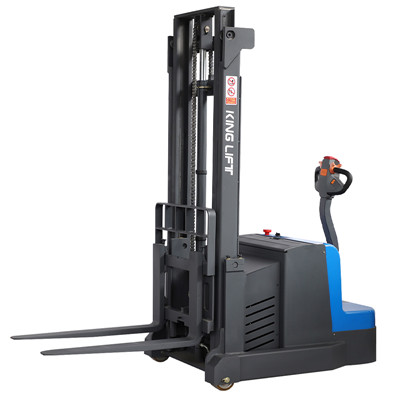 Instructions for using automatic pallet jackNovember 03, 2022
Instructions for using automatic pallet jackNovember 03, 2022Notes on using automatic pallet jack
If you are thinking of using an automatic pallet jack in your business, there are a few things you should know. Here are some notes on using automatic pallet jack:
1. Make sure that the area where you will be using the automatic pallet jack is clear of obstacles. This will help prevent accidents.
2. When loading or unloading a pallet, make sure that the pallet is level. This will help prevent the pallet from tipping over.
3. Be careful when moving the automatic pallet jack around corners. This is because the wheels can get caught on objects and cause the pallet jack to tip over.
4. Make sure that you always use the proper safety equipment when operating the automatic pallet jack. This includes gloves, safety glasses, and a safety helmet.
It is very important to know how to use an automatic pallet jack properly in order to avoid any accidents. Here are some tips on using an automatic pallet jack:
- Make sure that the area around the pallet jack is clear and free of obstacles before beginning to use it.
- Always wear proper safety gear, including gloves and closed-toe shoes, when using the pallet jack.
- Never try to move a load that is too heavy for the pallet jack or yourself.
- Be careful when moving the pallet jack around corners or through doorways, as its large size can make it difficult to maneuver.
- Once you have finished using the pallet jack, always put it back in its proper place so that it is ready for the next person to use.
How to use self loading pallet jack
Using a self-loading pallet jack is an easy and efficient way of transporting goods from one place to another. This type of equipment eliminates the need for liftgates, ramps, hoists and conventional pallet jacks.
It is easy to operate: simply load the cargo into the van, truck, or delivery vehicle and pull the support. The self-loading stacker then climbs into the vehicle itself, using the same space as a hand pallet. Self-loading forklifts come in a variety of forms, depending on the type of forklift needed. Platform stackers and work positioners, self-propelled pallet trucks, floor level loaders are all available.
With this machine, it is possible to easily handle 1000kg heavy pallets and load them onto a delivery truck. It is important to consider its total weight when moving it around.
How to choose automatic pallet jack
The following tips will help you choose the right automatic pallet jack for your needs:
1. Choose the right size
2. Consider the load capacity
3. Think about the terrain
4. Choose the right type of drive system
If you are working in a warehouse or any other type of business that requires you to move heavy objects around, then you know that an automatic pallet jack can be a lifesaver. But how do you choose the right one for your needs? Here are a few tips:
- Consider the weight capacity. This is probably the most important factor to consider when choosing an automatic pallet jack. You need to make sure that it can handle the weight of the objects that you will be moving around.
- Consider the size. Another important factor to consider is the size of the automatic pallet jack. You need to make sure that it is small enough to maneuver around in your work space, but large enough to handle the objects that you need to move.
- Consider the price. Automatic pallet jacks can range in price from a few hundred dollars to several thousand dollars. You need to find one that fits within your budget while still providing the features and benefits that you need.
Electric Forklift Manufacturers
The electric forklift is an important piece of industrial equipment used in many warehouses and factories around the world. It significantly increases productivity, safety, and efficiency for a variety of different tasks. As such, it is important to select the right electric forklift manufacturers for your needs. This article explores the various aspects of choosing the best electric forklift manufacturers to meet your requirements.
China Forklift Manufacturer - Kinlift
Kinlift is one of the leading China forklift manufacturers that offers a wide range of high-performance forklifts. Their reliable, durable and affordable products have gained them immense recognition in the market. They have established a strong presence in both Chinese and international markets for their superior quality standards and competitive pricing. Kinlift uses advanced production technologies to create efficient, reliable and cost-effective forklifts suitable for various applications.
READ MORE -
 Application guide for battery powered forkliftNovember 02, 2022
Application guide for battery powered forkliftNovember 02, 2022How to pick battery powered forklift
The first thing you need to do is identify what type of battery powered forklift truck you need. There are three main types:
1. Electric counterbalanced forklifts
3. Electric pallet jacks and stackers
Once you know what type of truck you need, the next step is to select the right battery. There are three main types of batteries used in forklifts:
1. Lead-acid batteries
2. Nickel-cadmium (NiCd) batteries
3. Lithium-ion (Li-ion) batteries
First, you need to understand the basics of how a battery powered forklift works. A battery powered forklift is an electric forklift that uses a battery to power the drive motors. The battery is usually located underneath the seat of the forklift, and it is connected to the drive motors by a series of wires.
The advantage of a battery powered forklift over a gas or diesel powered forklift is that it does not produce any emissions, so it is better for the environment. It is also much quieter than a gas or diesel powered forklift, so it can be used in places where noise levels need to be kept low.
Another advantage of a battery powered forklift is that it does not require any fuel, so you do not have to worry about storing or transporting gasoline or diesel fuel. And since there are no emissions, you do not have to worry about complying with emissions regulations.
The disadvantages of a battery powered forklift include the fact that they are more expensive than gas or diesel powered forklifts, and they require more maintenance than gas or diesel models. They also have shorter run times than gas or diesel models, so you will need to plan
How to maintain battery powered forklift
1. Check the water level in the battery regularly.
2. Keep the top of the battery clean and free of dirt and debris.
3. Inspect the terminals and connectors for corrosion and clean them as needed.
4. Avoid overcharging the battery.
5. Store the battery in a cool, dry place when not in use.
Here are some tips for how to maintain your battery powered forklift:
- Check the water level in the batteries regularly.
- Keep the batteries clean and free of dirt and debris.
- Inspect the cables and terminals for damage.
- Avoid overcharging or deep discharging the batteries.
- Store the batteries in a cool, dry place when not in use.
How to choose forklift solid tires
When it comes to choosing the right type of tire for your forklift, there are a few things you need to take into consideration. The first is the terrain that you'll be driving on. If you're only going to be driving on pavement, then you can get away with using pneumatic tires. However, if you're going to be driving on any type of rough terrain, then you'll need to use solid tires.
Another thing to consider is the weight of the load that you'll be carrying. If you're only going to be carrying light loads, then pneumatic tires will work just fine. But if you're going to be carrying heavy loads, then you'll need solid tires in order to prevent the tires from getting damaged.
Finally, you need to think about how often you'll be using your forklift. If you're only going to be using it occasionally, then pneumatic tires might be the way to go. But if you're going to be using your forklift on a daily basis, then solid tires are definitely the way to go since they'll last longer and won't get damaged as easily.
When it comes to choosing tires for your forklift, there are a few things you need to take into consideration. The first is the type of terrain you'll be using the forklift on. If you're only using it on smooth surfaces, then pneumatic (air-filled) tires would be a good choice. But if you're using it on rough or uneven terrain, then solid tires would be a better option.
The second thing to consider is the weight of the load you'll be carrying. If you're only carrying light loads, then pneumatic tires would probably be fine. But if you're carrying heavy loads, then solid tires would give you better traction and stability.
Finally, you need to decide what size tire you need. Forklifts come in different sizes, so make sure to get the right size tire for your particular model.
Once you've considered all of these factors, you should have no trouble choosing the right type of tire for your forklift.
READ MORE -
 4 wheel electric forklift application guideNovember 02, 2022
4 wheel electric forklift application guideNovember 02, 2022How to use 4 wheel electric forklift
First and foremost, you'll need to ensure that the 4 wheel electric forklift is charged. If it's not, you won't be able to use it. Once it is charged, you can begin using it by:Pressing the power button to turn on the machineUsing the joystick to control the direction of the machinePressing the pedal to make the machine move forwards or backwards
If you need to pick something up with the forks, you can do so by:
Using the joystick to lower or raise the forks
Pushing or pulling on the item with the forks until it is secure
If you have an electric forklift with four wheels, you may be wondering how to properly use and maintain it. Here are some tips:
- Check the battery regularly. This is especially important if you live in a cold climate, as the battery will discharge faster in cold weather.
- Keep the tires inflated to the proper pressure. This will help extend their life and improve your forklift's performance.
- Follow the manufacturer's recommendations for maintenance and repairs. This will help keep your forklift running smoothly and prevent expensive repairs down the road.
How to maintain a 4 wheel electric forklift
1. Check the battery regularly.
2. Keep the wheels clean and free of debris.
3. Inspect the forks for damage.
4. Lubricate the moving parts on a regular basis.
It’s important to maintain your 4 wheel electric forklift on a regular basis to prevent issues and keep it running smoothly. Here are a few tips on how to do that:
- Check the tires regularly and inflate them as needed
- Check the brakes and make sure they are working properly
- Lubricate all moving parts on a regular basis
- Keep the battery charged and clean the terminals as needed
- Inspect the forks for damage and replace them if necessary
READ MORE -
 Used Electric Forklift User GuideOctober 31, 2022
Used Electric Forklift User GuideOctober 31, 2022Top Pros and Cons of Used Forklifts
The foremost benefit of buying a used forklift is cost. Used forklifts can be purchased for thousands of dollars less than new forklifts. Also, brand and model recalls can also be avoided with a used forklift purchase.
When it comes to disadvantages, the biggest con for used forklifts is it may require more maintenance and repair than new ones. And more importantly, they may not have the latest features that could be more beneficial for your business.
READ MORE
